

Riding a bike in the city can be scary. If you’ve ever done it, you’ve probably had at least one close call — it comes with the territory. In 2016, 840 cyclists were killed in motor vehicle crashes in the United States. Over 70% of those took place in urban areas, where there tend to be more cars and bicycles on the roads.
The number of cyclist fatalities due to car accidents has increased over the last decade, up from 628 fatalities in 2009. This is likely, at least in part, the result of more people bicycling nationwide. Nearly 864,000 people reported commuting to work by bicycle in 2016, a 50% increase from 2000.
Though the booming bicycle commuting trend has been tapering off in the last few years, falling 4.7% from 2016 to 2017, some major cities still have seen consistent growth in commuter cycling. Not surprisingly, most of these cities also have invested in bicycle infrastructure such as adding bike lanes, reducing speeds on city streets, and making it easier for bicycle commuters to take their bikes on public transit.
An increase in bicycle-related infrastructure not only leads to more cyclists hitting the streets, but also can lead to a decrease in cycling fatalities. Studies have shown that areas with bike lanes — especially protected lanes that provide a barrier between cyclists and moving traffic — are safer for cyclists. The installation of protected bike lanes in New York City has been shown to reduce all traffic-related fatalities in the areas of installation.
This may explain the weak correlation between between the number of cycling fatalities and the percentage of bicyclists in a given city. Some cities are just far safer for bicyclists than others.
Other factors that influence the bicycle fatality rate in a city are climate, which causes seasonal fluctuations in the biking population, speed limits, tourist drivers, distracted drivers, and alcohol consumption.
Click here to read about the safest and most dangerous cities for bikers.
To identify the most dangerous (and safest) cities for bikes, 24/7 Wall St. reviewed the number of bicyclists and riders of other pedal-driven vehicles who died in traffic crashes in 2016 — the most recent year for which data is available.
The fatality rate is defined as the number of deaths from crashes per every 1 million people and was obtained for the 32 U.S. cities with populations of 500,000 people or more from the National Highway Traffic Safety Administration. The percentage of residents commuting to work by bike came from the U.S. Census Bureau’s 2017 American Community Survey. Population data is for 2017 and also came from the Census.

1. Jacksonville, Florida
> Bicyclist fatality rate: 8.0 per 1 million people
> Bicyclist fatalities: 7
> Population: 867,313
> Total traffic fatalities: 149
> Working-age pop. commuting by bike: 0.5%
Jacksonville had a high number of total traffic fatalities in 2016 — 149 compared to 28 in San Francisco, a city with a very similar population size — of which seven were bicyclists. Per capita, the city has the highest bicyclist fatality rate, and the city saw an overall downward trend in cycle commuting from 1990 to 2017. Due to the high level of danger that bikers in Jacksonville face, the city has developed a plan to improve bicycle safety on the roads and also implemented countdown clocks at select crosswalks and installed bike lanes on many streets.
[in-text-ad]

2. Portland, Oregon
> Bicyclist fatality rate: 7.8 per 1 million people
> Bicyclist fatalities: 5
> Population: 630,331
> Total traffic fatalities: 43
> Working-age pop. commuting by bike: 6.5%
Named the No. 1 bike-friendly city in the U.S. for years by Bicycling magazine, Portland nevertheless has more bicycle deaths per capita than almost any other city. It also has more bike commuters than any other city on this list. Of Portland commuters, over 6%, or 22,647 people, bike to work — 10 times the national average. Along with Portland’s booming population, traffic fatalities have increased as well, especially on the city’s arterial roads — wide thoroughfares with four lanes or more. With over 350 miles of designated bike paths and 40 years worth of city bike policies, however, you can’t say Portland isn’t trying to encourage safe biking.
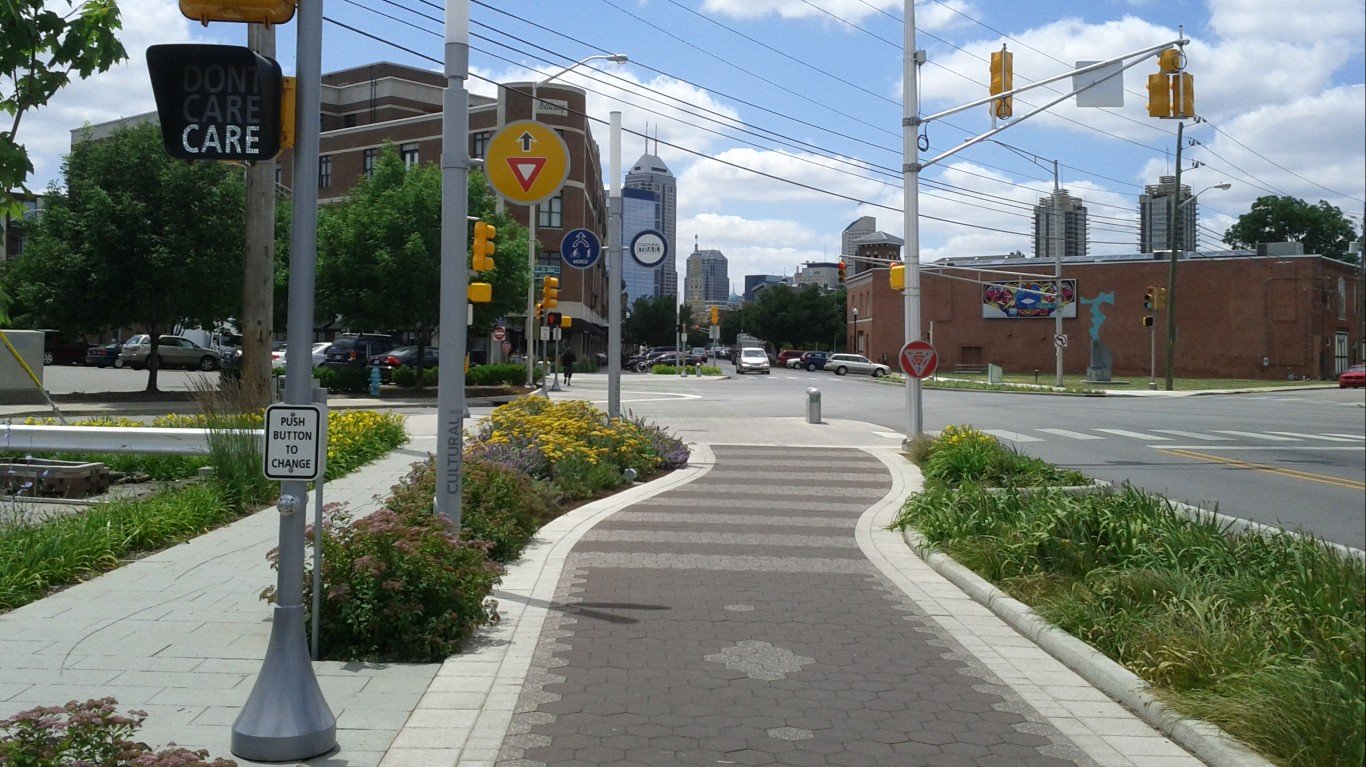
3. Indianapolis, Indiana
> Bicyclist fatality rate: 7.0 per 1 million people
> Bicyclist fatalities: 6
> Population: 853,431
> Total traffic fatalities: 96
> Working-age pop. commuting by bike: 0.5%
Marion County, Indiana, which comprises the Indianapolis metro-area, had 175 reported bike collisions by motor vehicles in 2016, six of which were fatal. Though they face budgetary and legislative roadblocks, multiple bicycle advocacy organizations in Indianapolis have confronted lawmakers about making the streets safer for bikes, including implementing a law that prohibits cars from passing within 3 feet of a bicycle.
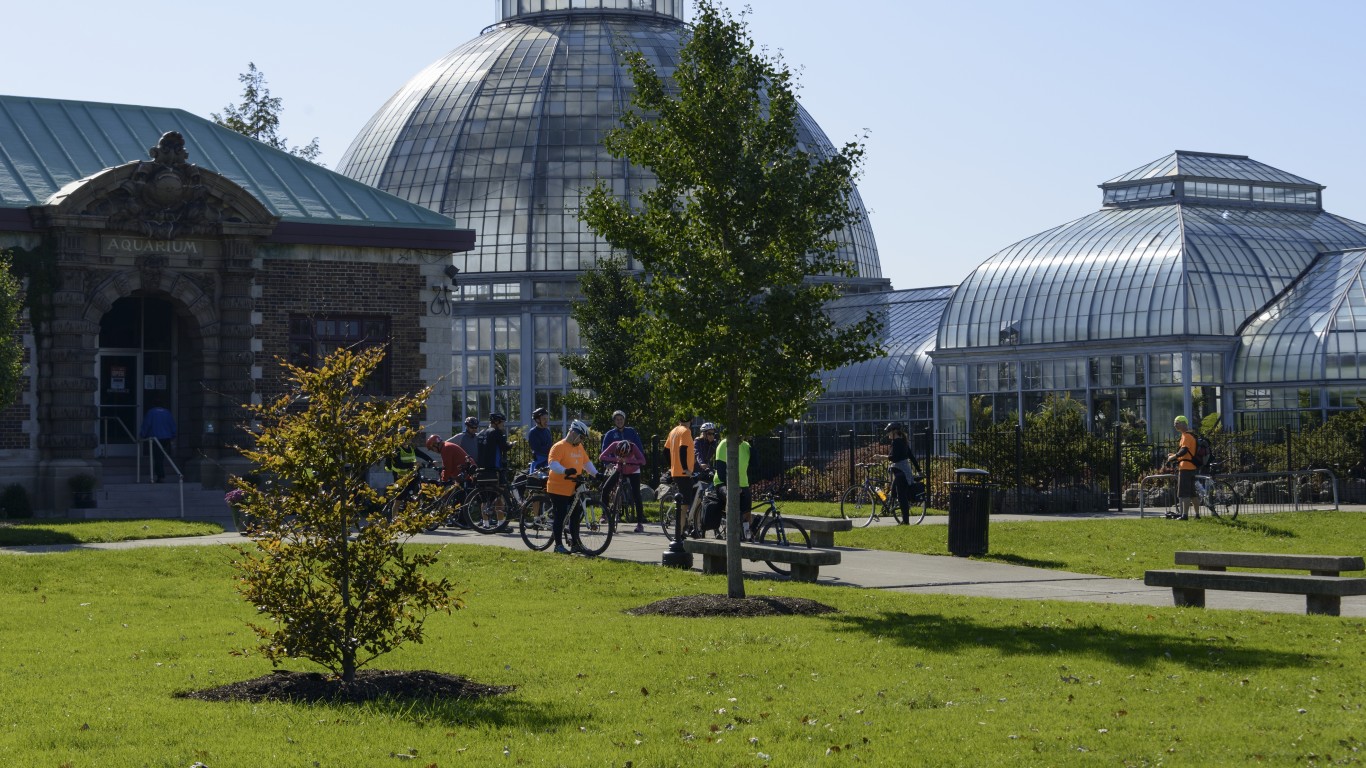
4. Detroit, Michigan
> Bicyclist fatality rate: 6.0 per 1 million people
> Bicyclist fatalities: 4
> Population: 679,865
> Total traffic fatalities: 118
> Working-age pop. commuting by bike: 0.8%
In 2016, 170 Detroit cyclists reported vehicle collisions. Being the former center of the automotive industry, the Motor City was designed with multiple lanes of fast-moving traffic in mind, leaving bicycles out of the picture. According to Jeffrey Nolish, a mobility specialist for Detroit’s planning department, who spoke with Detroit MetroTimes, the street designs and speed limits are a major factor in automobile collisions involving pedestrians and cyclists.
[in-text-ad-2]
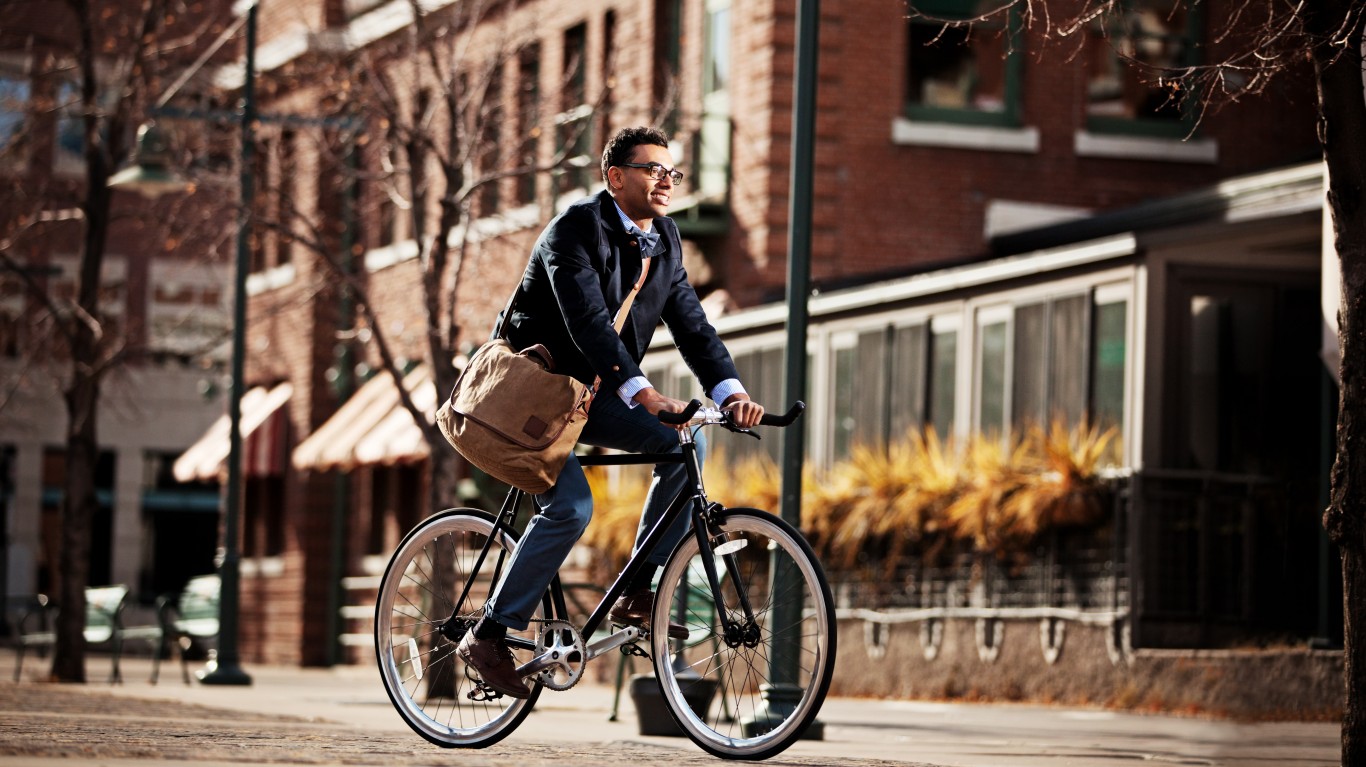
5. Denver, Colorado
> Bicyclist fatality rate: 5.8 per 1 million people
> Bicyclist fatalities: 4
> Population: 678,467
> Total traffic fatalities: 54
> Working-age pop. commuting by bike: 2.2%
Speed seems to be a factor in many traffic fatalities in Denver, where four cyclists were killed in 2016. To address the issue, Mayor Michael Hancock has instituted a plan to reduce speed limits, add traffic circles, and overhaul traffic patterns in major problem areas, such as Federal Boulevard, a highway that cuts through residential neighborhoods and has a traffic fatality rate 20 times higher than the average of other urban roads in Colorado.
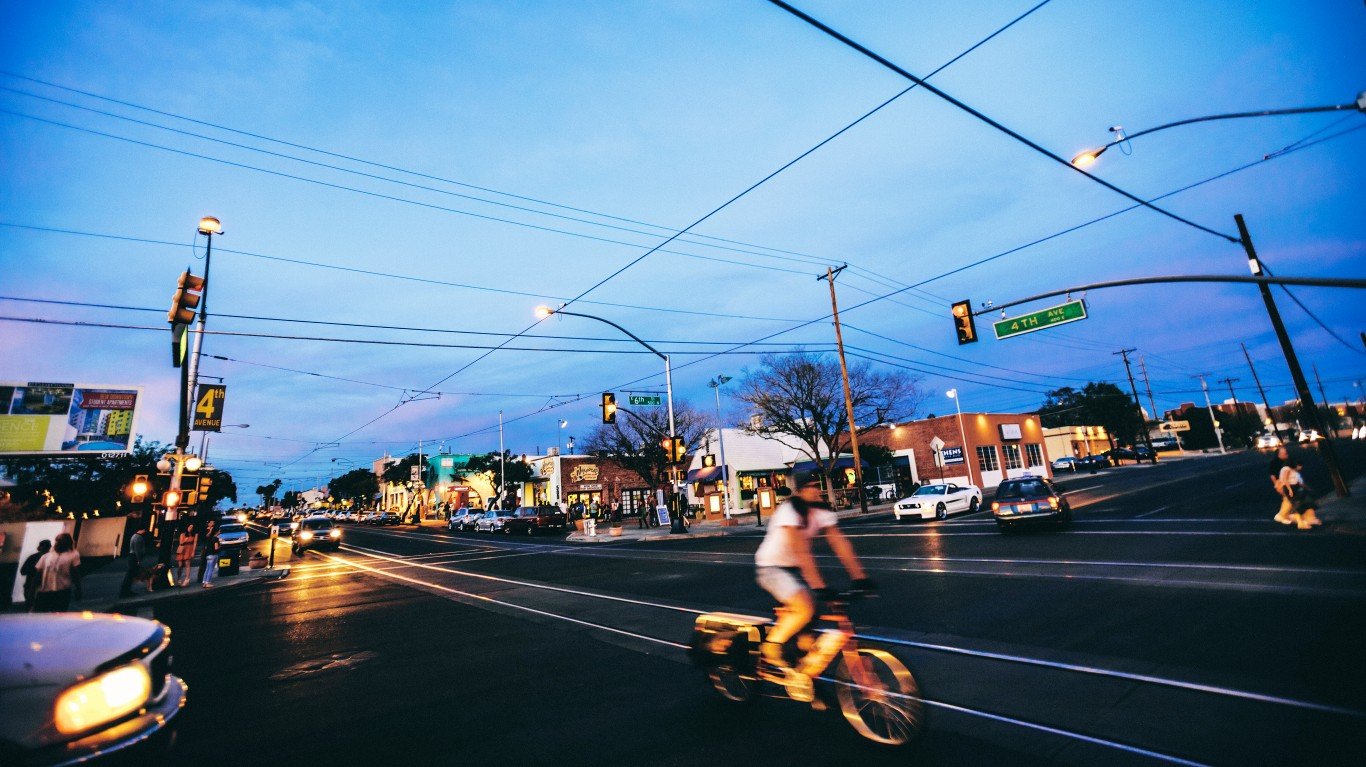
6. Tucson, Arizona
> Bicyclist fatality rate: 5.7 per 1 million people
> Bicyclist fatalities: 3
> Population: 530,905
> Total traffic fatalities: 59
> Working-age pop. commuting by bike: 2.9%
Tucson is a city that is proud of its bicycling population, with nearly 3% of commuters biking to work. In the ’80s and ’90s, the city invested heavily in cycling infrastructure, adding bike lanes to many roads and bike crossings to major streets. Though it has a nearly complete network of bike lanes on arterial streets, that doesn’t stop traffic fatalities. Tucson is now focused on connecting off-street paths and protected bike lanes to the network to offer increased distance between bikers and cars.
[in-text-ad]
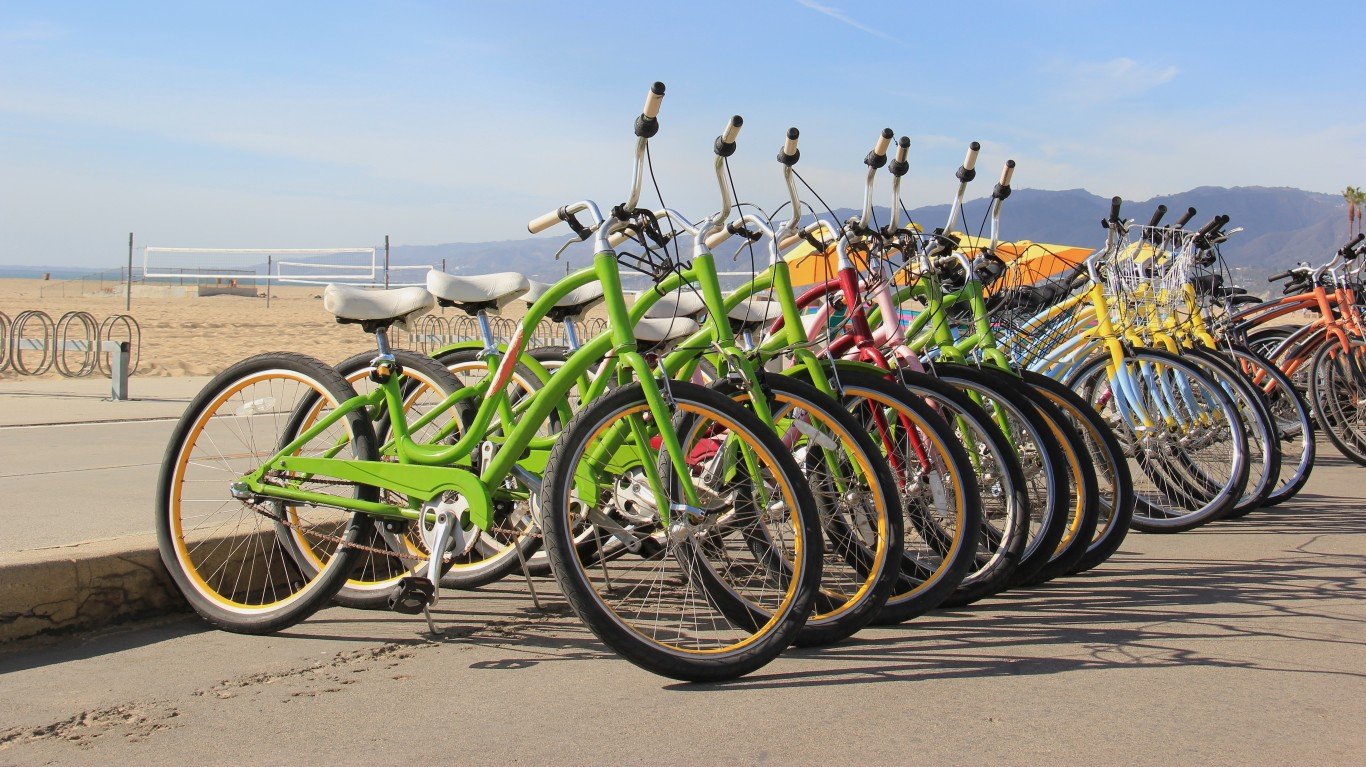
7. Los Angeles, California
> Bicyclist fatality rate: 5.0 per 1 million people
> Bicyclist fatalities: 20
> Population: 3,949,776
> Total traffic fatalities: 315
> Working-age pop. commuting by bike: 1.1%
Los Angeles had 20 cycling fatalities in 2016, the most of any city on this list and topping even New York City, which has over double the population of LA. Home to nearly 4 million people, LA is a congested city famous for its heavy traffic and 8-lane boulevards. Though LA launched a Vision Zero project in 2015 to curb fatalities and make roads safer, progress has been slow, and changes have been halted by pushback from drivers.
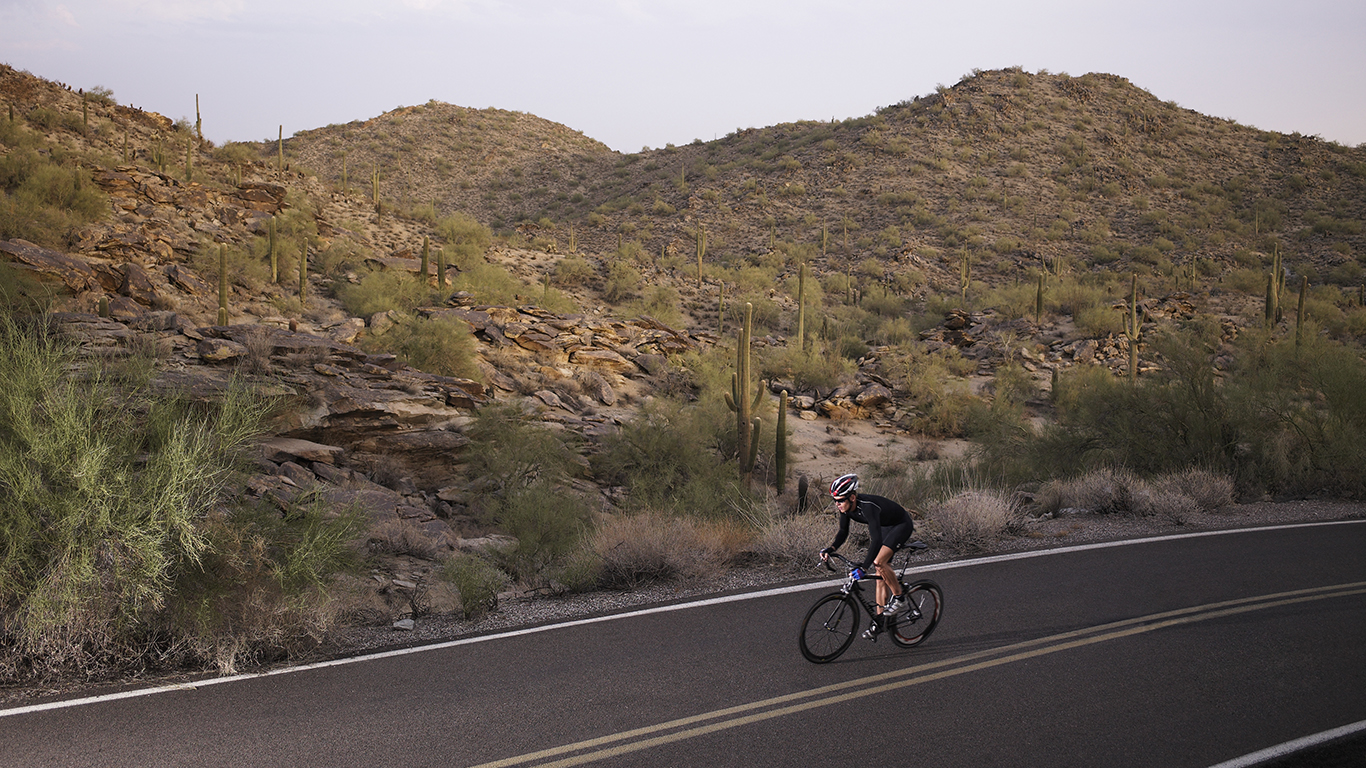
8. Phoenix, Arizona
> Bicyclist fatality rate: 5.0 per 1 million people
> Bicyclist fatalities: 8
> Population: 1,574,421
> Total traffic fatalities: 225
> Working-age pop. commuting by bike: 0.7%
In a car-centric city like Phoenix, where only 3.3% of commuters use public transit compared to about 5.1% of commuters nationwide, pedestrian and cyclist deaths are not uncommon. The city averaged one traffic fatality every 16 hours in 2016. With 40 mph speed limits the norm on most arterial streets, and many intersections lacking crosswalks, Phoenix was designed to move heavy traffic as quickly as possible rather than accommodate cyclists and pedestrians. Though pedestrian and bicycle advocacy groups have pressed for change, they’ve seen most plans halted at the city council level.
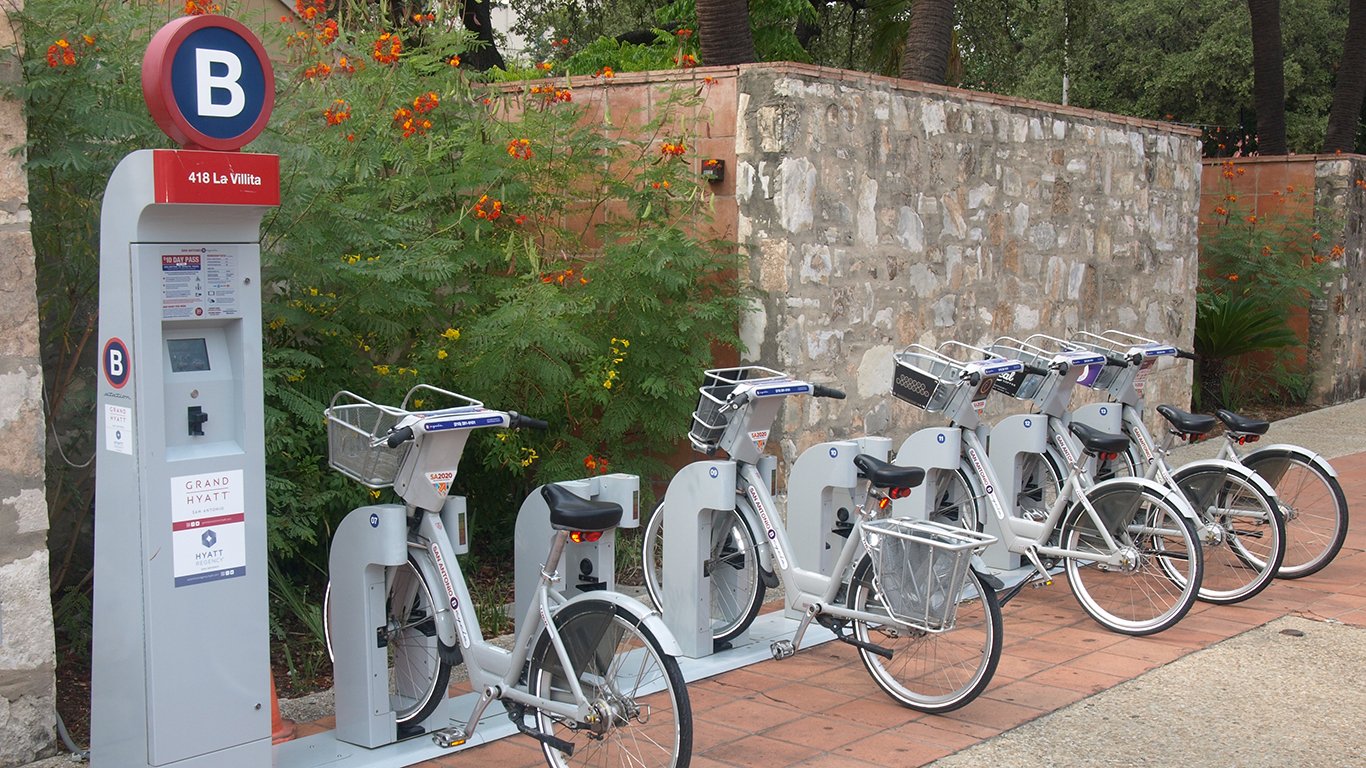
9. San Antonio, Texas
> Bicyclist fatality rate: 3.4 per 1 million people
> Bicyclist fatalities: 5
> Population: 1,461,623
> Total traffic fatalities: 194
> Working-age pop. commuting by bike: 0.2%
Compared to data from 2008, San Antonio cyclists are now twice as likely to be involved in automobile accidents. There were 362 bicycle crashes reported in 2017, significantly more than the 196 reported in 2008. A few roads, such as Broadway, have higher than average numbers of pedestrian and bicycle accidents and fatalities. As of February of this year, the city was working on a plan to install protected bike lanes on Broadway.
[in-text-ad-2]
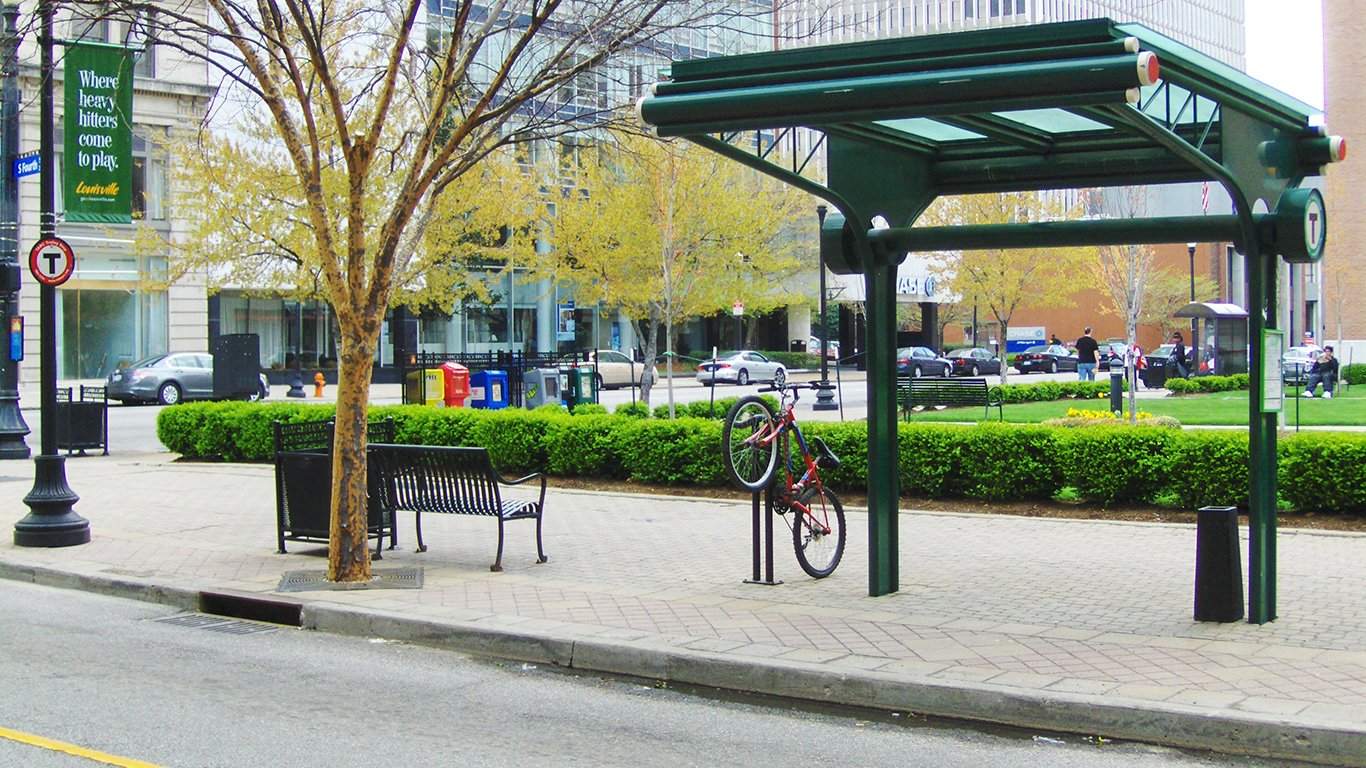
10. Louisville/Jefferson County, Kentucky
> Bicyclist fatality rate: 3.3 per 1 million people
> Bicyclist fatalities: 2
> Population: 615,478
> Total traffic fatalities: 87
> Working-age pop. commuting by bike: 0.4%
Louisville has been making great strides in its bicycling infrastructure but still has work to do to eliminate fatalities. Though the city has installed miles of buffered bike lanes, which can be converted to protected bike lanes in the future, most of its bike lanes are “sharrow lanes,” which are shared with cars and still pose a risk to bikers.

11. Las Vegas, Nevada
> Bicyclist fatality rate: 3.2 per 1 million people
> Bicyclist fatalities: 2
> Population: 621,662
> Total traffic fatalities: 58
> Working-age pop. commuting by bike: 0.4%
Though the Las Vegas valley has almost 500 miles of bike lanes and another 370 miles of paved bike trails, the city’s main streets were designed for automobile traffic. Bicycle commuting rates in Las Vegas fell over 75% from 2009 to 2017. The Strip, where many distracted tourists drive, is not conducive to biking and is the scene of many pedestrian fatalities. Bikers in Vegas would be smart to stick to the trails.
[in-text-ad]
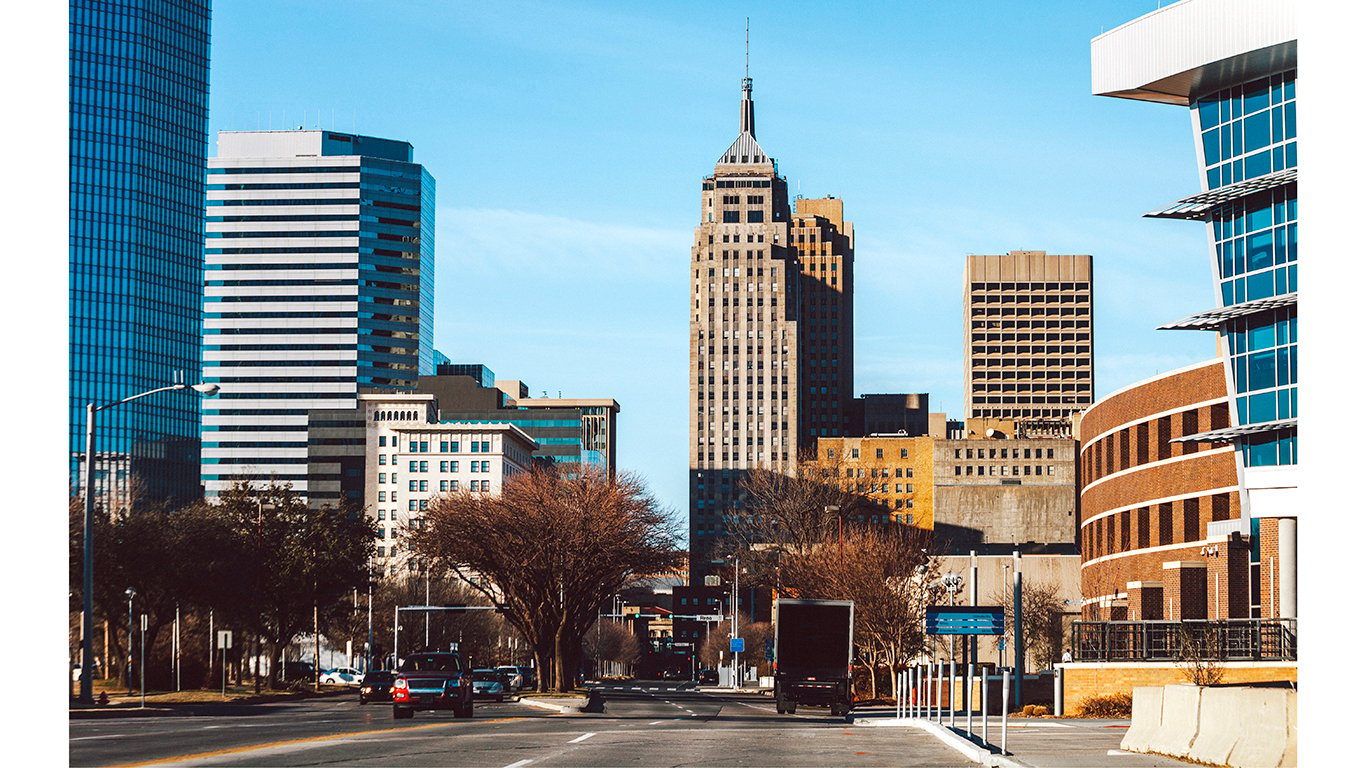
12. Oklahoma City, Oklahoma
> Bicyclist fatality rate: 3.1 per 1 million people
> Bicyclist fatalities: 2
> Population: 629,191
> Total traffic fatalities: 87
> Working-age pop. commuting by bike: 0.2%
In a city where only 0.2% of the commuting population cycles to work, a lack of bicycle awareness on the part of drivers may be a strong factor in crashes and fatalities. Studies have shown that the more bicyclists there are in an area, the less likely they are to be involved in an accident. This is due in part to increased vigilance on the part of drivers, who tend to drive more safely when they see more cyclists and pedestrians. Oklahoma City has made moves to increase awareness to street cyclists by installing road signs stating “Bicycles may use full lane.”
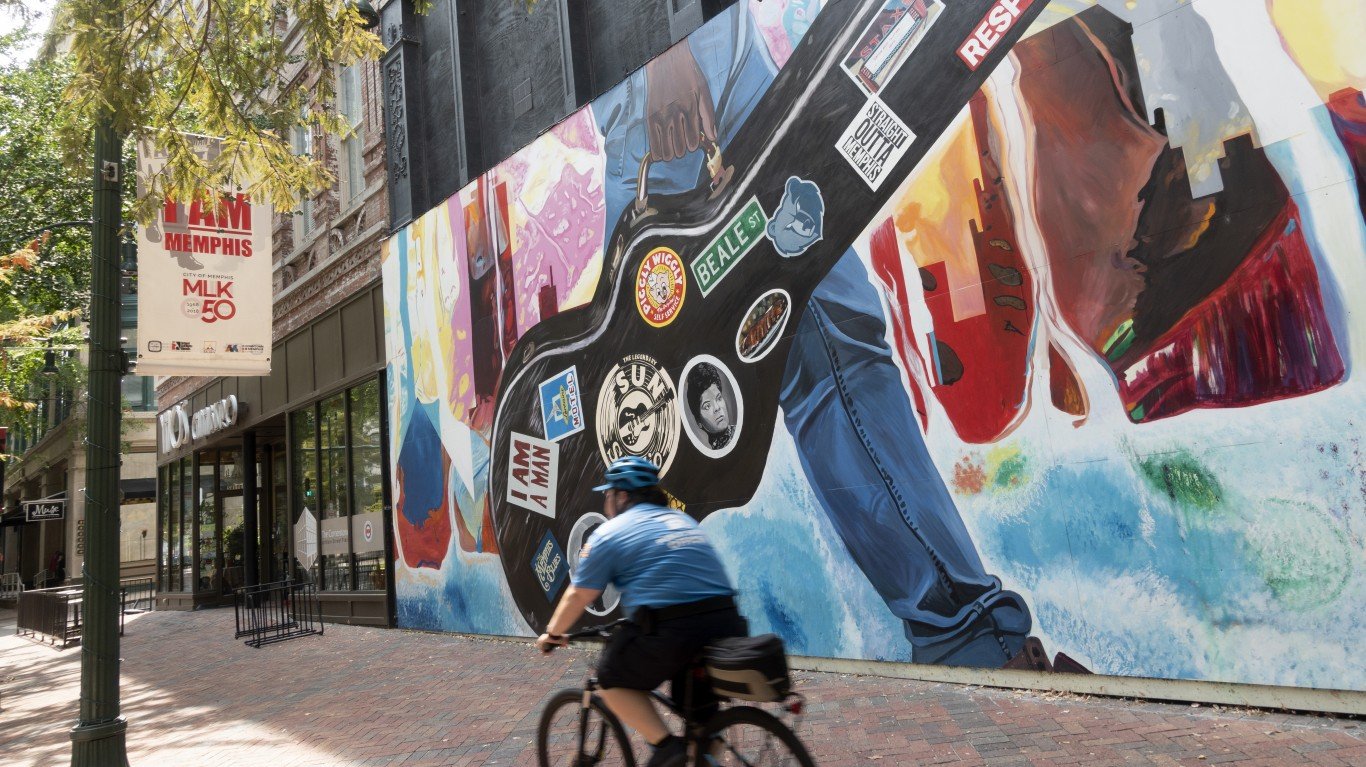
13. Memphis, Tennessee
> Bicyclist fatality rate: 3.1 per 1 million people
> Bicyclist fatalities: 2
> Population: 654,723
> Total traffic fatalities: 120
> Working-age pop. commuting by bike: 0.2%
Over the last two decades, Memphis has added significant cycling infrastructure to its streets, including a 10-mile bike path called the Green Line, a bike share program, and over 200 miles of bike lanes. Because the streets that still lack bike-friendly infrastructure are the site of 93% of bike crashes, Memphis encourages residents to stick to the trails and designated bike paths when biking.
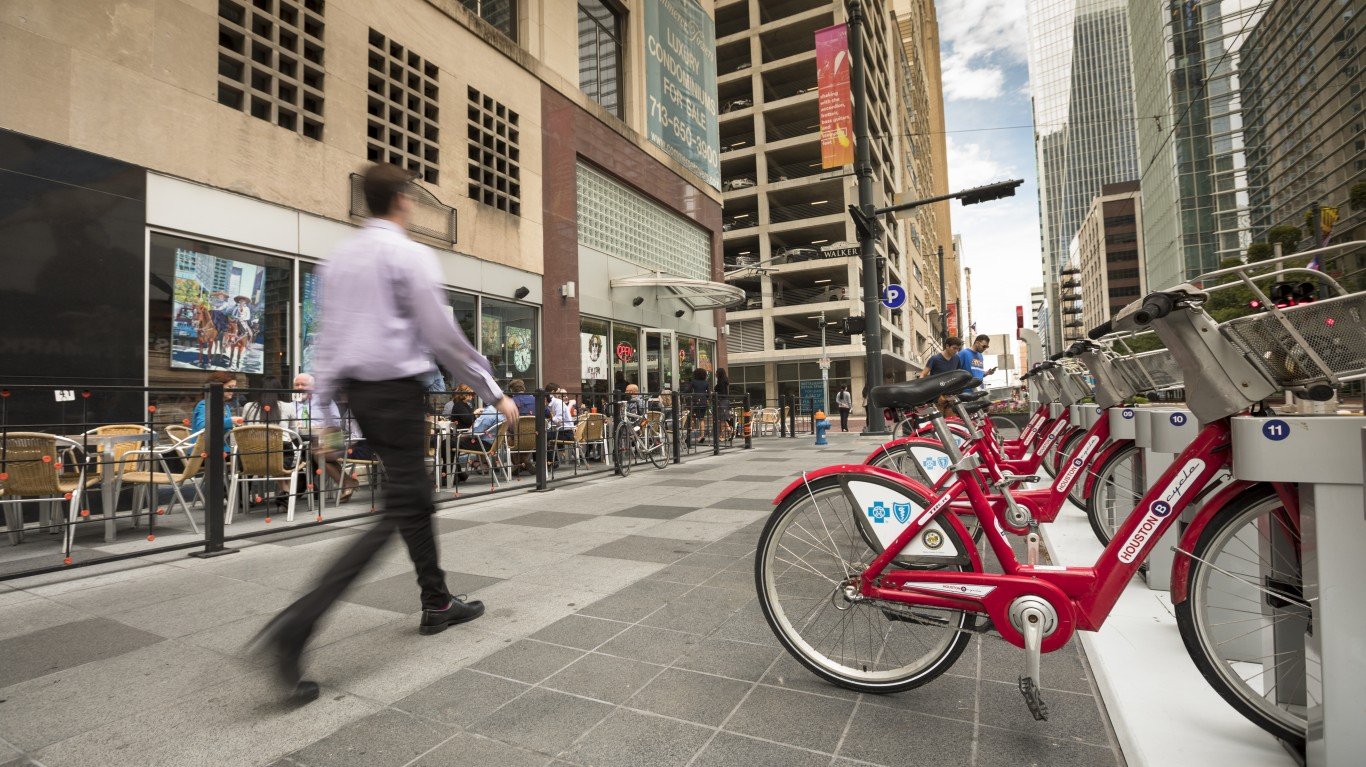
14. Houston, Texas
> Bicyclist fatality rate: 3.0 per 1 million people
> Bicyclist fatalities: 7
> Population: 2,267,336
> Total traffic fatalities: 248
> Working-age pop. commuting by bike: 0.5%
There was a sharp increase in bicycle fatalities in Houston, from seven in 2016 to 21 in 2017. Local bicycle advocacy groups have staged protests and called for more convictions for drivers who hit or kill pedestrians or bicyclists. Since 2010, only a quarter of suspects in pedestrian or bicycle death cases have been charged, and when they have, it’s often been for a lesser offense, like leaving the scene of a crime.
[in-text-ad-2]
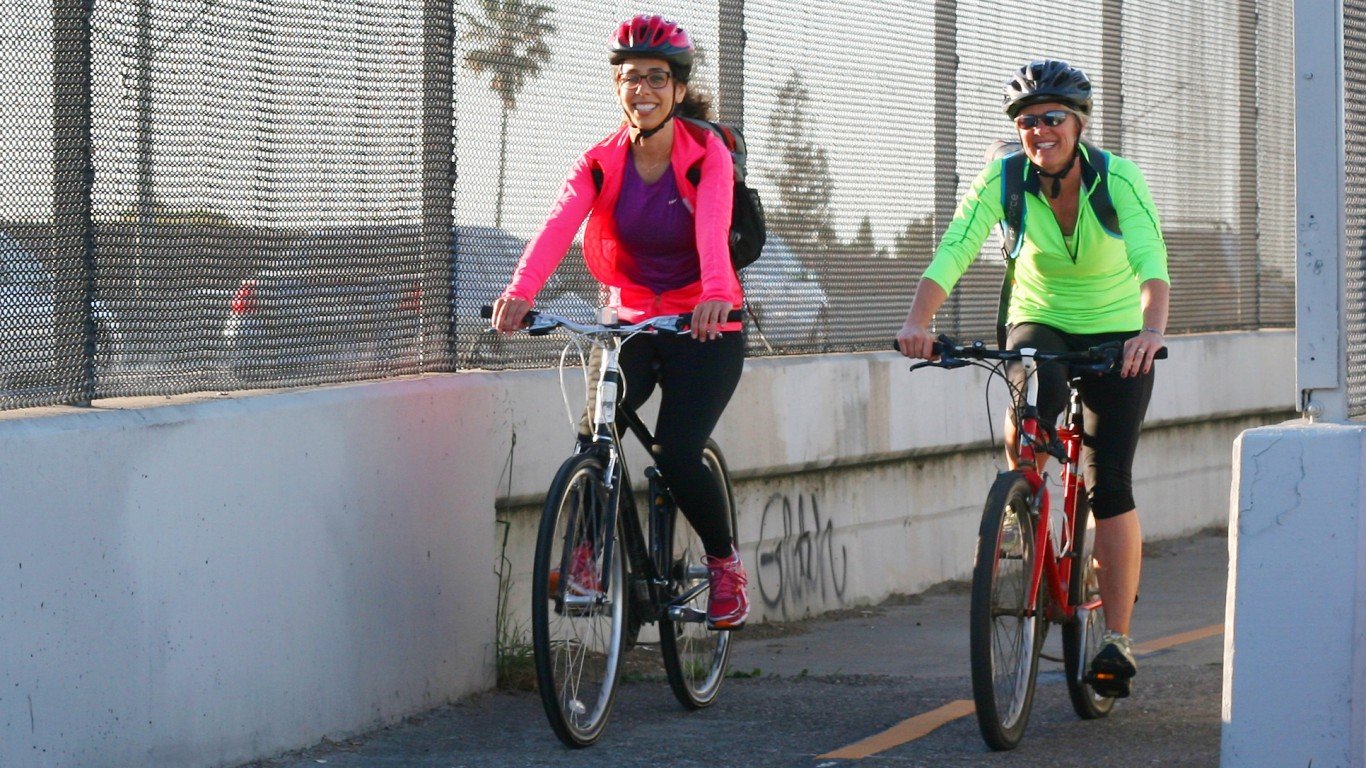
15. San Jose, California
> Bicyclist fatality rate: 2.9 per 1 million people
> Bicyclist fatalities: 3
> Population: 1,023,031
> Total traffic fatalities: 60
> Working-age pop. commuting by bike: 0.9%
As part of the city’s Better Bikeways initiative, San Jose has been adding protected bike lanes to many streets as they are repaved, as well as installing traffic diverters. Though San Jose averages about 600 pedestrian and bicycle injuries a year due to automobile collisions, that number dropped to 450 in 2017, and hopefully will continue to decline as the roads become safer.
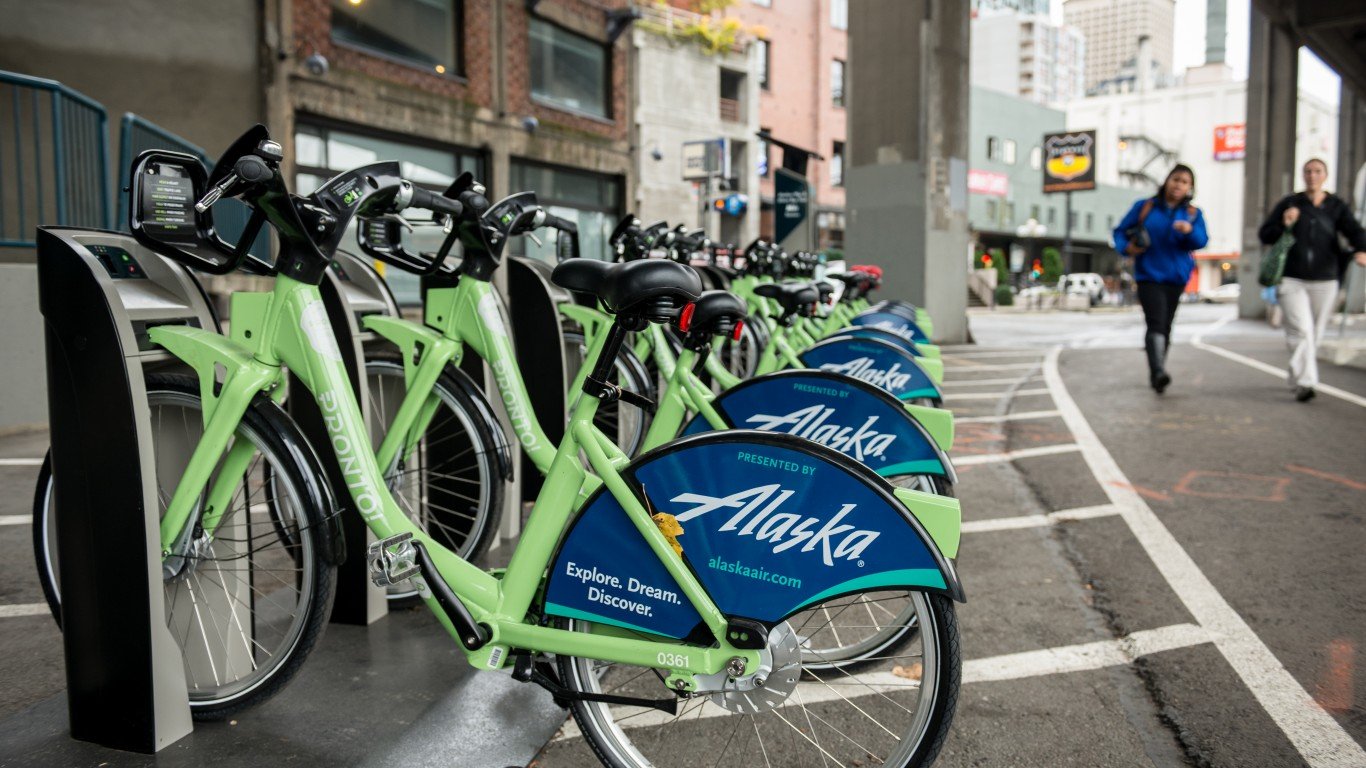
16. Seattle, Washington
> Bicyclist fatality rate: 2.8 per 1 million people
> Bicyclist fatalities: 2
> Population: 688,245
> Total traffic fatalities: 27
> Working-age pop. commuting by bike: 3.5%
As the Seattle grows, more and more of its population is commuting by other means — 21.4% of the working-age population is using public transit, and 3.5% cycle. Seattle’s traffic fatalities are relatively low in comparison to cities with similar populations — it has half as many fatalities as Denver and a third as many as Charlotte, North Carolina. Despite the relatively low fatality rate, 26 bikers were still seriously injured in car accidents in 2016. Plans to improve infrastructure consistently meet with pushback from residents.
[in-text-ad]

17. New York City, New York
> Bicyclist fatality rate: 2.2 per 1 million people
> Bicyclist fatalities: 19
> Population: 8,560,072
> Total traffic fatalities: 230
> Working-age pop. commuting by bike: 1.2%
Over 800,000 New Yorkers bike regularly, and 86,000 bike to work or school. An additional 56.5% of the working-age population commutes by public transit, the highest percentage in the nation. Because cities with high public transit use have consistently lower rates of traffic fatalities, the streets of New York City are relatively safe for cyclists. In recent years, the city has expanded the bike network significantly, adding over 300 miles of bike lanes, including 68 miles of protected lanes.
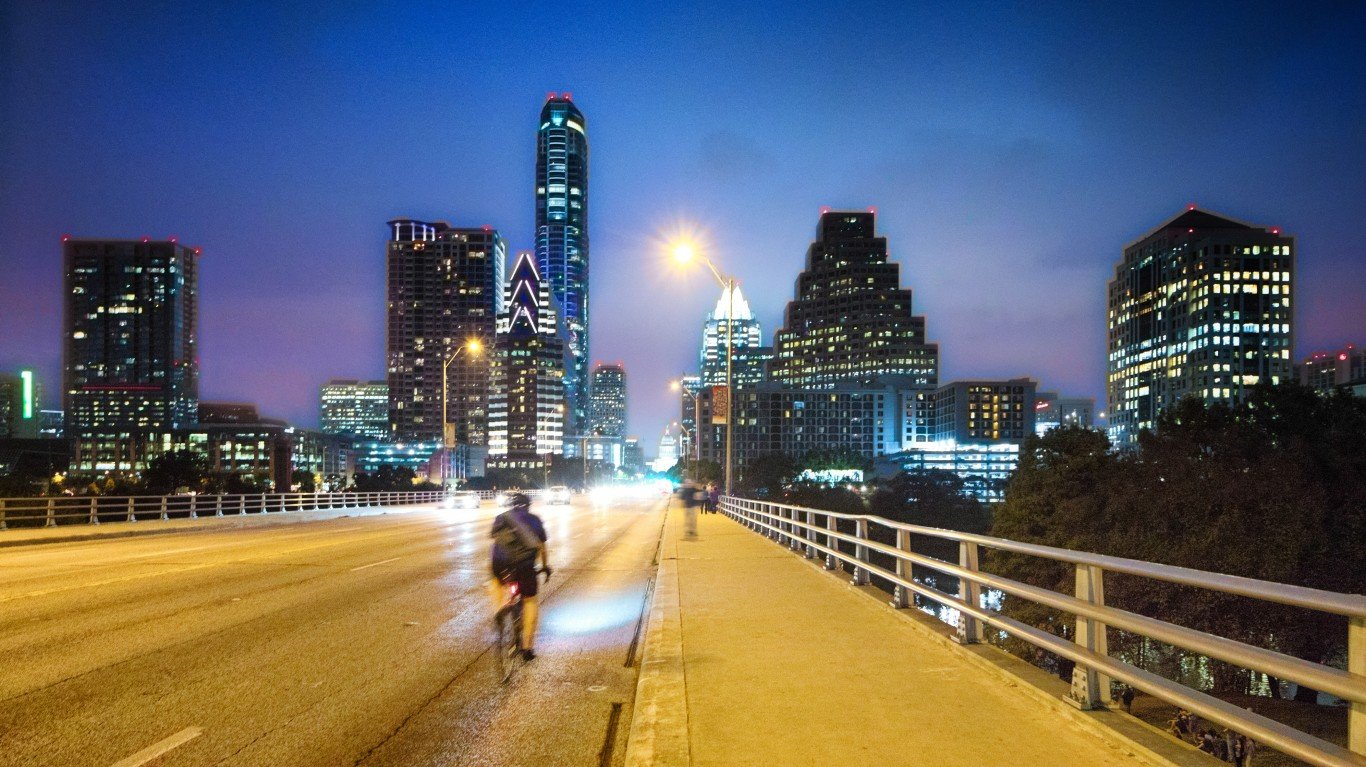
18. Austin, Texas
> Bicyclist fatality rate: 2.1 per 1 million people
> Bicyclist fatalities: 2
> Population: 916,906
> Total traffic fatalities: 86
> Working-age pop. commuting by bike: 1.3%
After a record number of cyclist deaths and injuries in 2012, Austin’s transportation department began work on hundreds of new bike lanes throughout the city. The number of cyclist collisions has been decreasing ever since. Though accident rates have not declined in areas with no bike lanes, the city’s hundreds of miles of bike lanes and 30 miles of bike trails are relatively safe places for Austin’s cyclists.
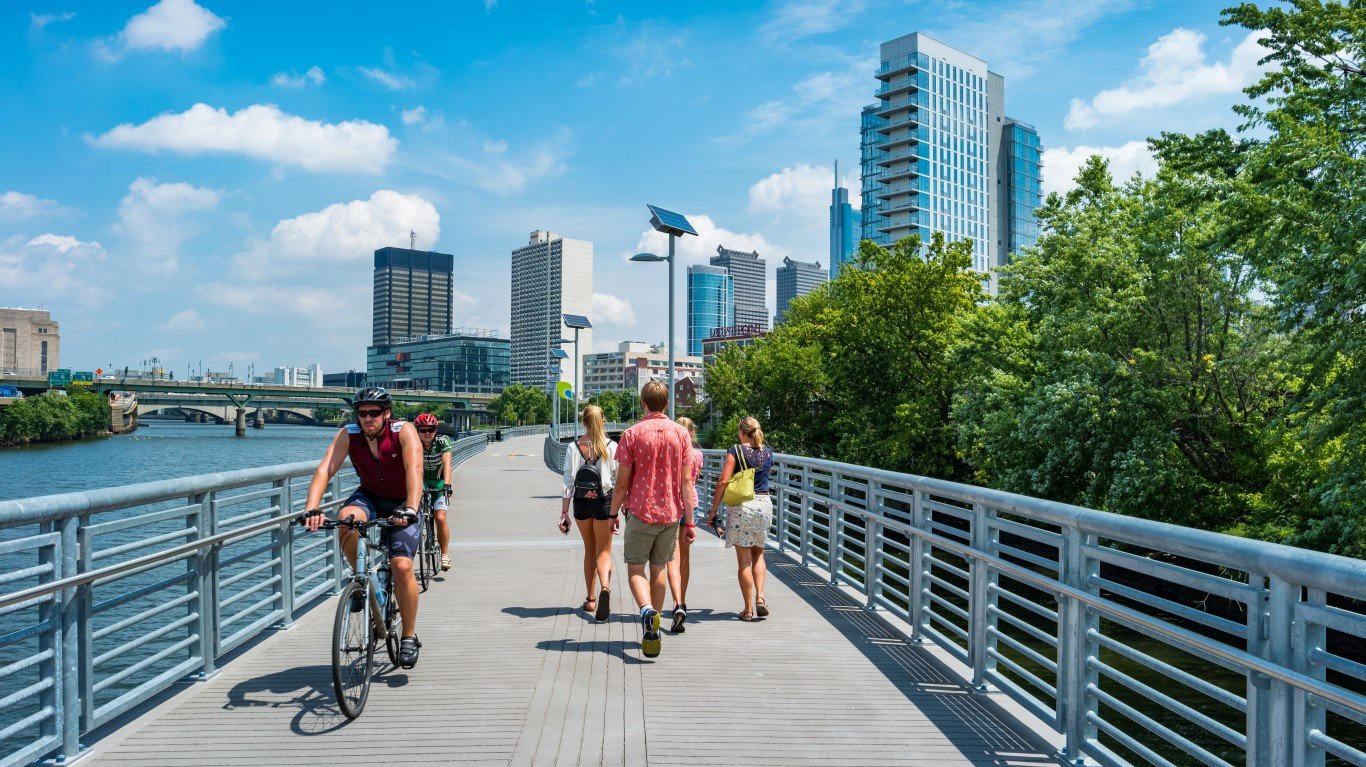
19. Philadelphia, Pennsylvania
> Bicyclist fatality rate: 1.9 per 1 million people
> Bicyclist fatalities: 3
> Population: 1,569,657
> Total traffic fatalities: 101
> Working-age pop. commuting by bike: 2.1%
Among the nation’s 10 most populous cities, Philadelphia has the most people biking per capita. The city’s bike share program, coupled with the option for cyclists to take their bikes onto buses and some trains, contributes to the ease of travelling by bike. With over a quarter of its working population commuting by transit instead of automobile, Philadelphia is one of the safer large cities to bike in.
[in-text-ad-2]
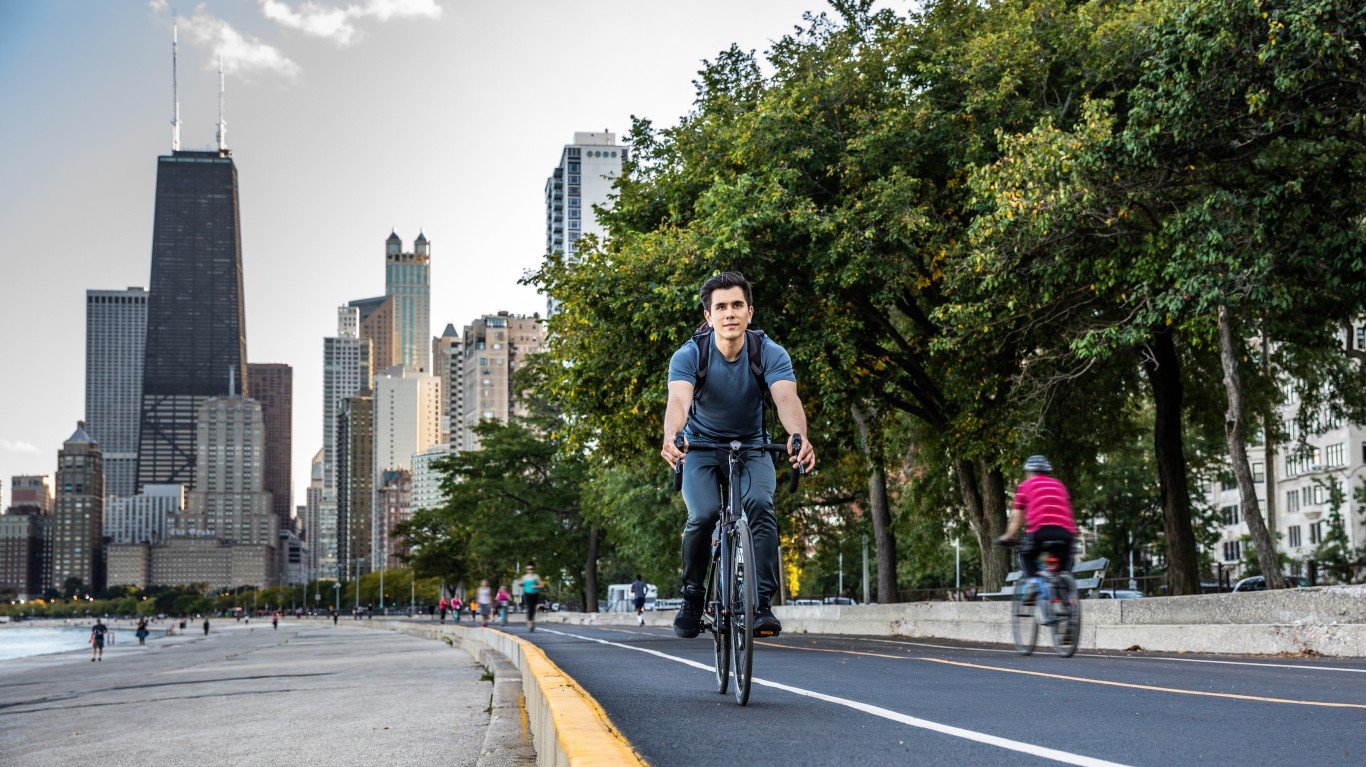
20. Chicago, Illinois
> Bicyclist fatality rate: 1.9 per 1 million people
> Bicyclist fatalities: 5
> Population: 2,722,586
> Total traffic fatalities: 123
> Working-age pop. commuting by bike: 1.7%
Like many other cities on this list, Chicago has adopted a Vision Zero plan for eliminating traffic fatalities. Part of this plan includes installation of protected bike lanes and reducing speed limits on roads with heavy bike traffic. Coupled with a high percentage of transit commuters — over 28% — Chicago’s 200 miles of bike lanes help keep the city’s cyclists safe.
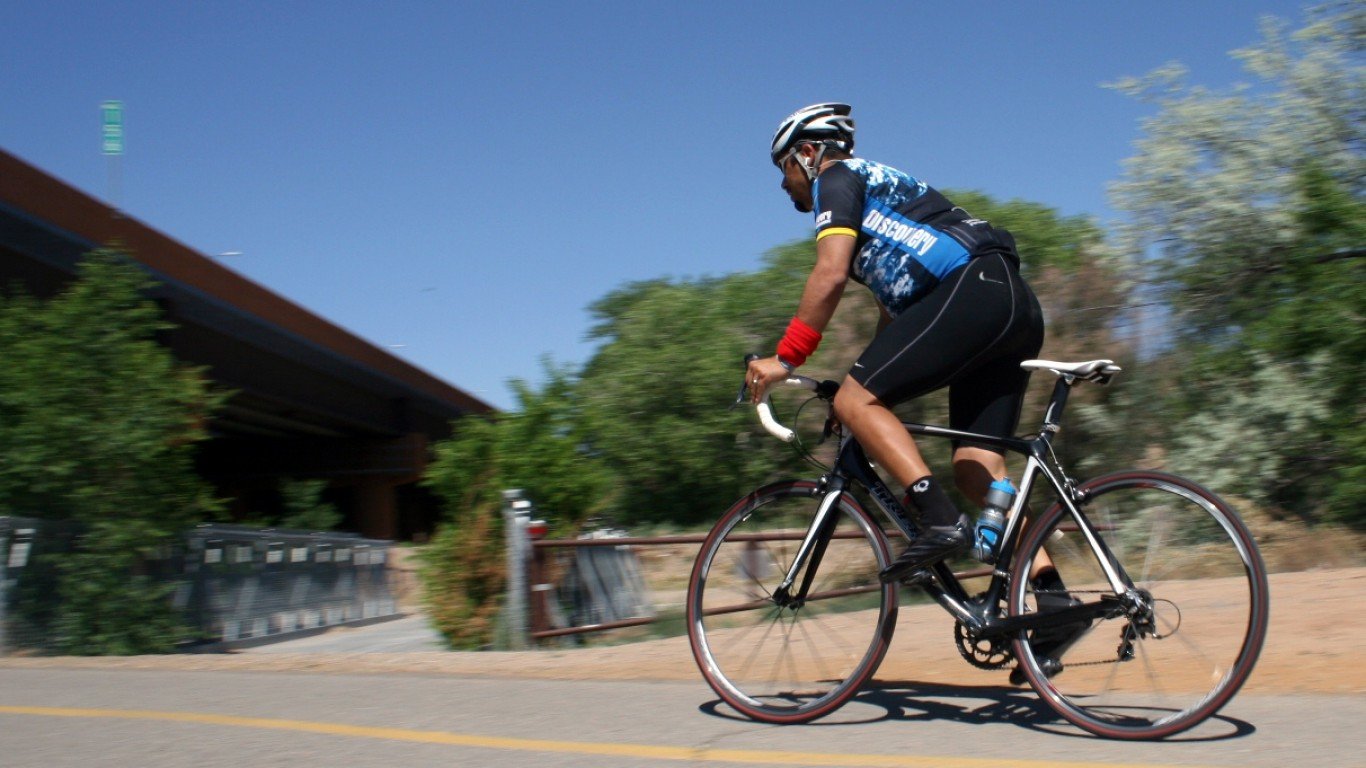
21. Albuquerque, New Mexico
> Bicyclist fatality rate: 1.8 per 1 million people
> Bicyclist fatalities: 1
> Population: 556,718
> Total traffic fatalities: 94
> Working-age pop. commuting by bike: 1.4%
Albuquerque prides itself on being a safe place for bicyclists. With over 400 miles of bike paths and extensive trail systems, cyclists can easily get around the city. There’s even a paved trail that runs for 16 miles along the Rio Grande, where cyclists can get from the north to south ends of the city without crossing any roads.
[in-text-ad]
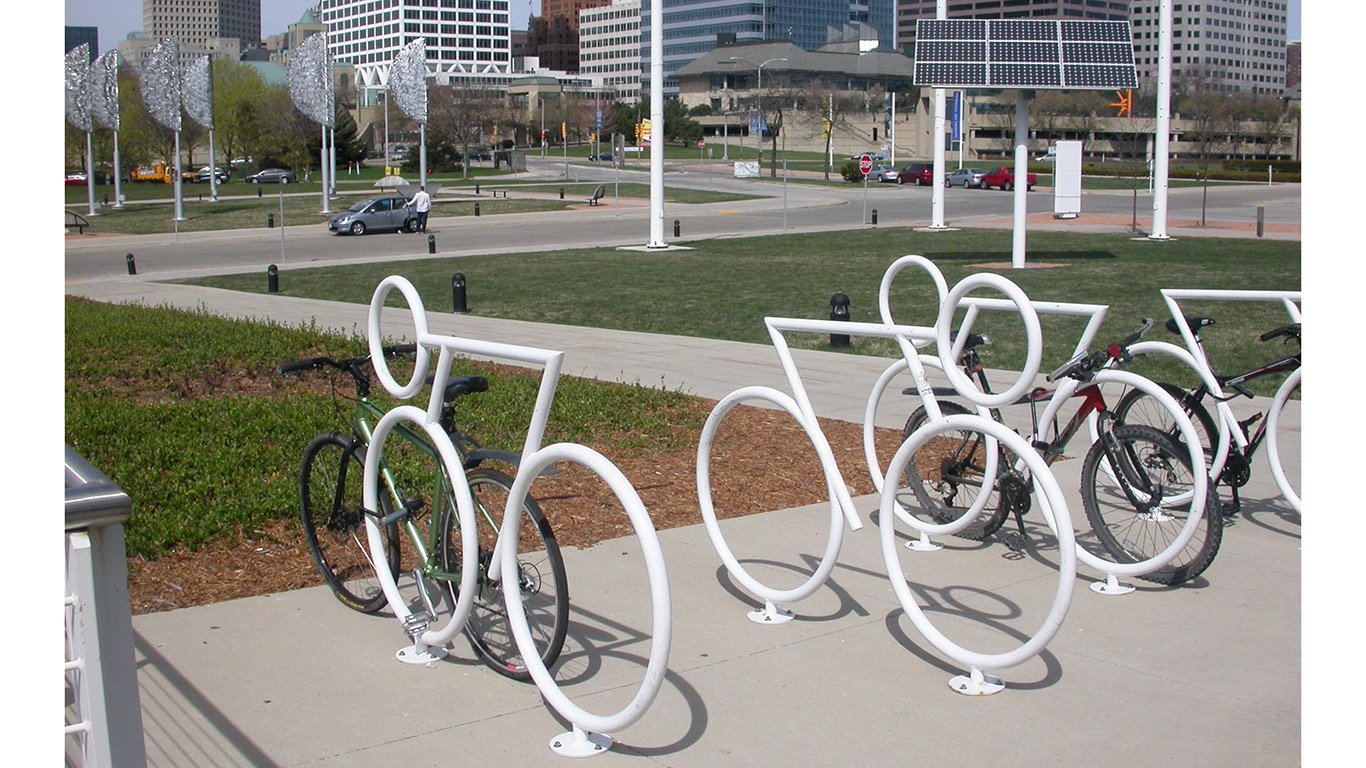
22. Milwaukee, Wisconsin
> Bicyclist fatality rate: 1.7 per 1 million people
> Bicyclist fatalities: 1
> Population: 599,086
> Total traffic fatalities: 59
> Working-age pop. commuting by bike: 1.0%
In 2010, Milwaukee began implementing a plan to increase the number of cyclists and cycle commuters in the city. Since then, the city has installed over 120 miles of bike lanes, including some of its first protected bike lanes, and extensive bike trails including a 100-mile loop encircling Milwaukee County, as well as road signs alerting drivers to high bike traffic areas.
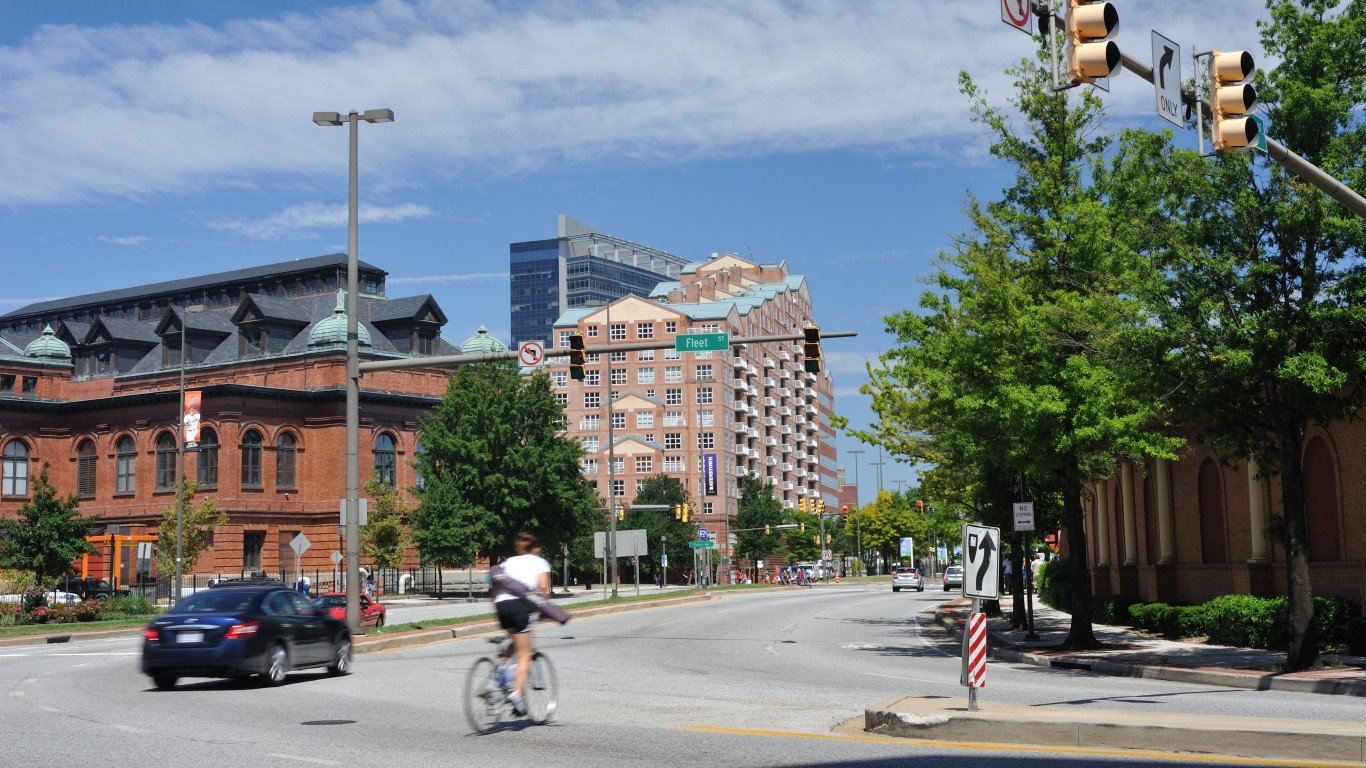
23. Baltimore, Maryland
> Bicyclist fatality rate: 1.6 per 1 million people
> Bicyclist fatalities: 1
> Population: 619,796
> Total traffic fatalities: 41
> Working-age pop. commuting by bike: 0.8%
Baltimore, Maryland, boasts a bicycle network that connects outlying neighborhoods to the city’s downtown with protected two-way bike lanes. Though the city has consistently delayed implementing further work that would connect existing bike lanes to one another, creating a full network as outlined in its 2015 Bike Master Plan, Baltimore’s existing infrastructure is enough to keep cyclists relatively safe.
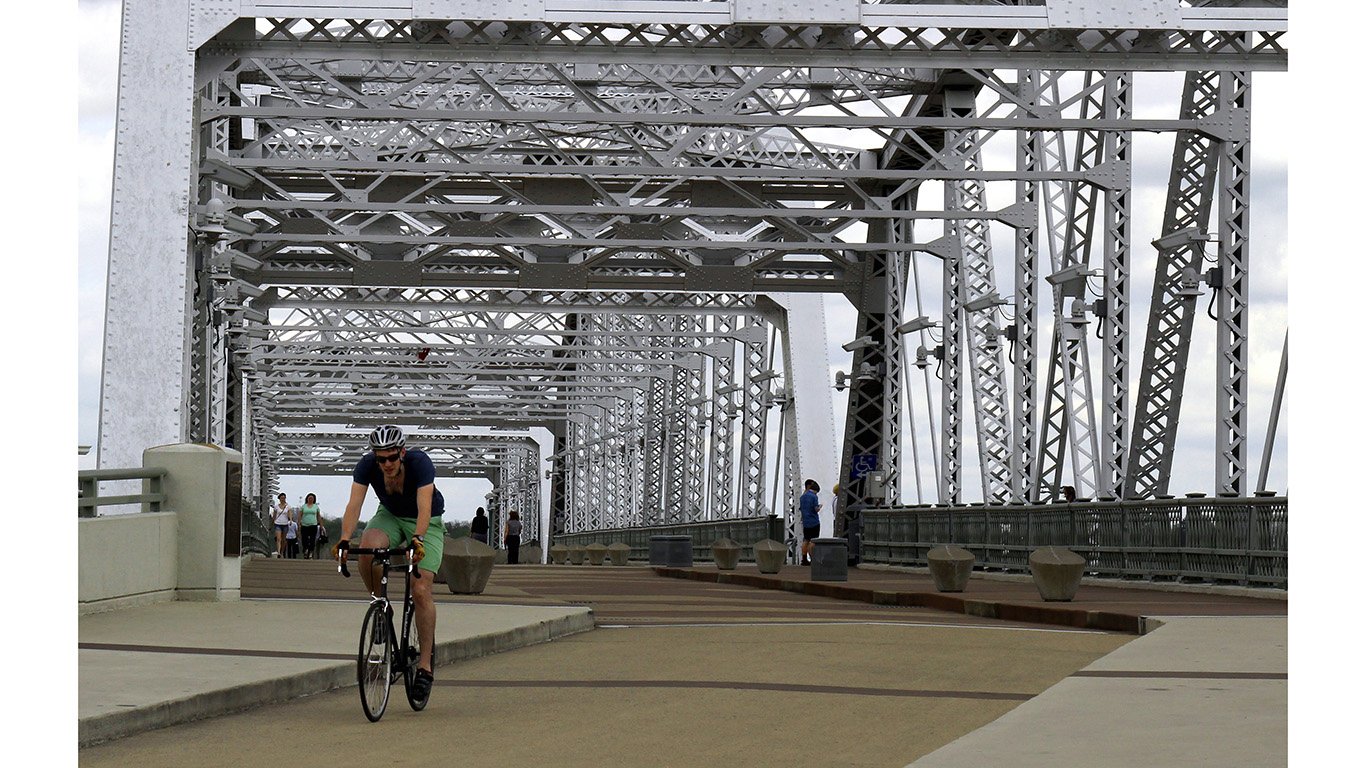
24. Nashville-Davidson, Tennessee
> Bicyclist fatality rate: 1.5 per 1 million people
> Bicyclist fatalities: 1
> Population: 654,187
> Total traffic fatalities: 65
> Working-age pop. commuting by bike: 0.2%
In the past 10 years, Nashville has installed nearly 140 miles of bike paths and lanes. The Music City Bikeway connects downtown Nashville with various residential neighborhoods, and a bike route called The Groove loops through the city, allowing bikers access to many parks, schools, and business districts. Not having to traverse miles of roads without bike lanes is a definite win for Nashville’s cyclists.
[in-text-ad-2]
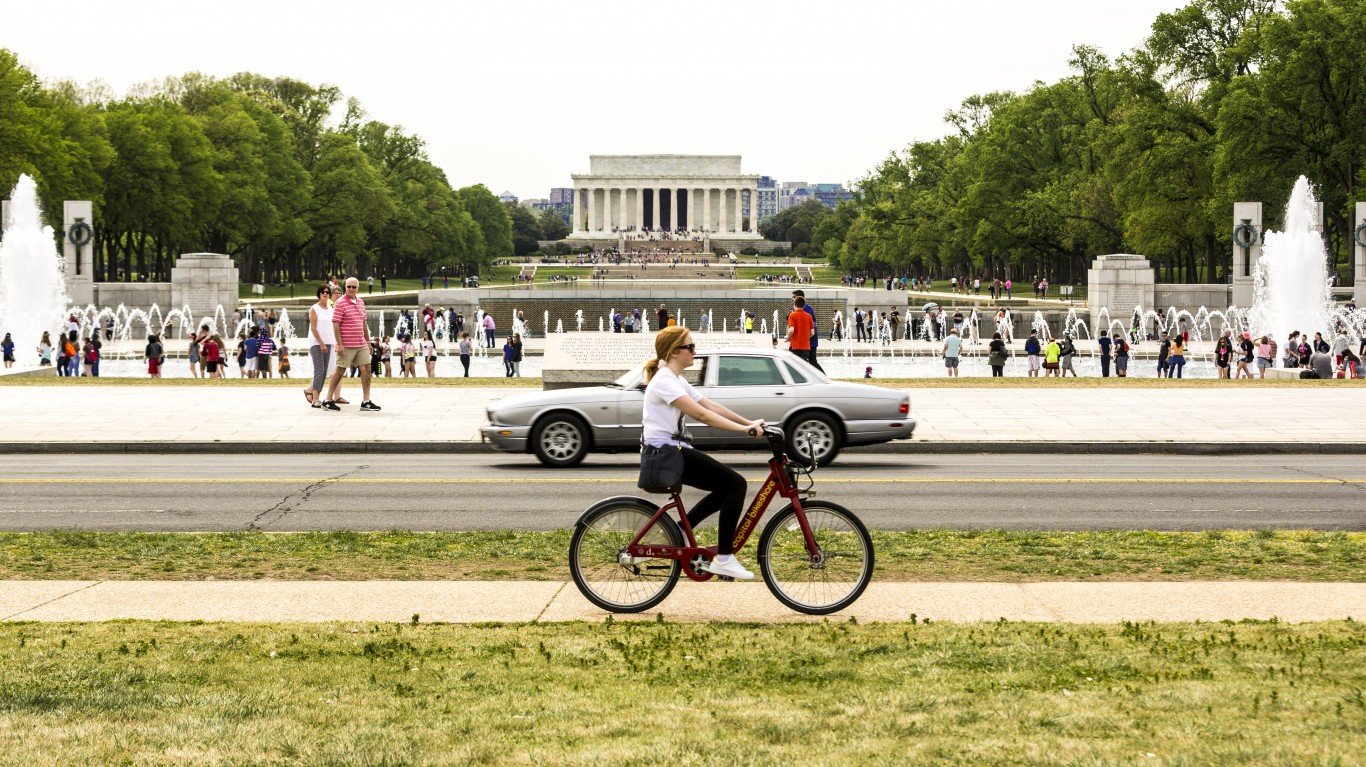
25. Washington, D.C.
> Bicyclist fatality rate: 1.5 per 1 million people
> Bicyclist fatalities: 1
> Population: 672,391
> Total traffic fatalities: 27
> Working-age pop. commuting by bike: 4.6%
Washington D.C. is home to the fastest growing cycle commuting population in the country, with 5% of its commuters — over 18,000 people — choosing to bike in 2016. Driers in communities with more cyclists tend to be more aware and these communities tend to have less fatalities. In addition to the high share of cyclists, over 35% of D.C.’s working population commutes by public transit, which tends to make the streets safer for everyone.
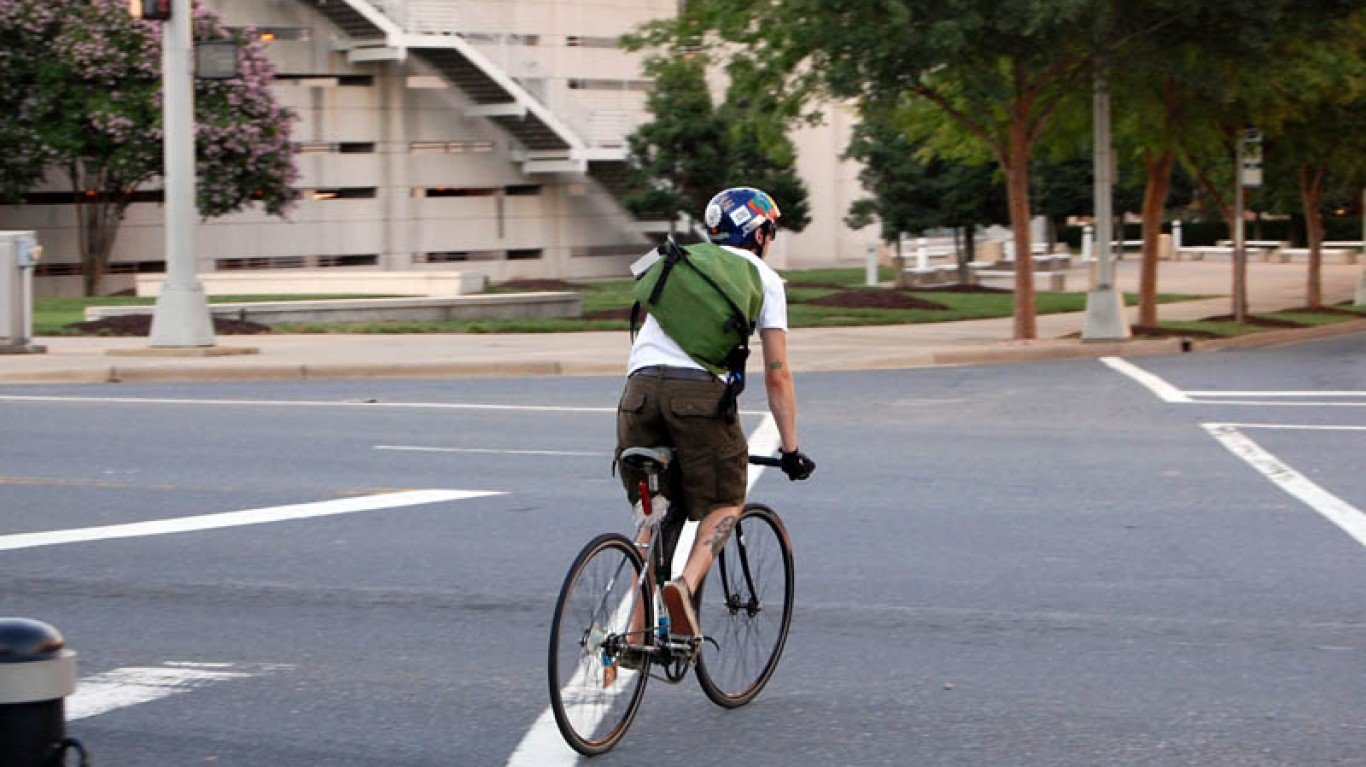
26. Charlotte, North Carolina
> Bicyclist fatality rate: 1.2 per 1 million people
> Bicyclist fatalities: 1
> Population: 826,060
> Total traffic fatalities: 93
> Working-age pop. commuting by bike: 0.2%
Charlotte has 100 miles of bike lanes and the city is planning to install a protected bike lane in its uptown district. Though bike lanes run through parts of uptown, the incidences of motorists parking in the bike lanes and public buses pulling in and out of them has led city officials to plan further safety measures for cyclists.
[in-text-ad]
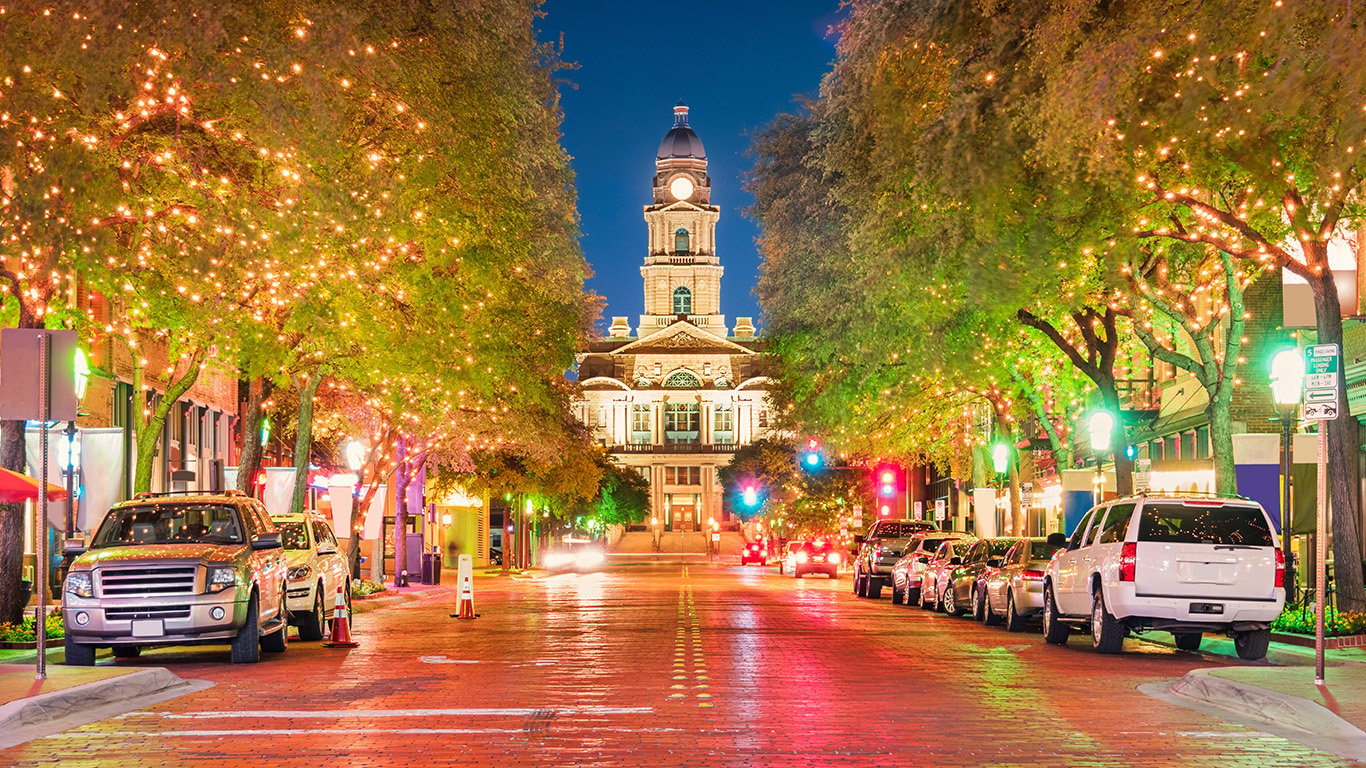
27. Fort Worth, Texas
> Bicyclist fatality rate: 1.2 per 1 million people
> Bicyclist fatalities: 1
> Population: 835,129
> Total traffic fatalities: 84
> Working-age pop. commuting by bike: 0.2%
Fort Worth is planning on installing over 1,000 miles of bike lanes and green trails. Bike Fort Worth is the city planning department’s initiative to promote cycling in the area. Its goals are to triple the number of bicycle commuters and decrease traffic accidents involving cyclists. Already home to dozens of off-street cycling areas and parks, Fort Worth is one of the safer places to bike in the U.S.
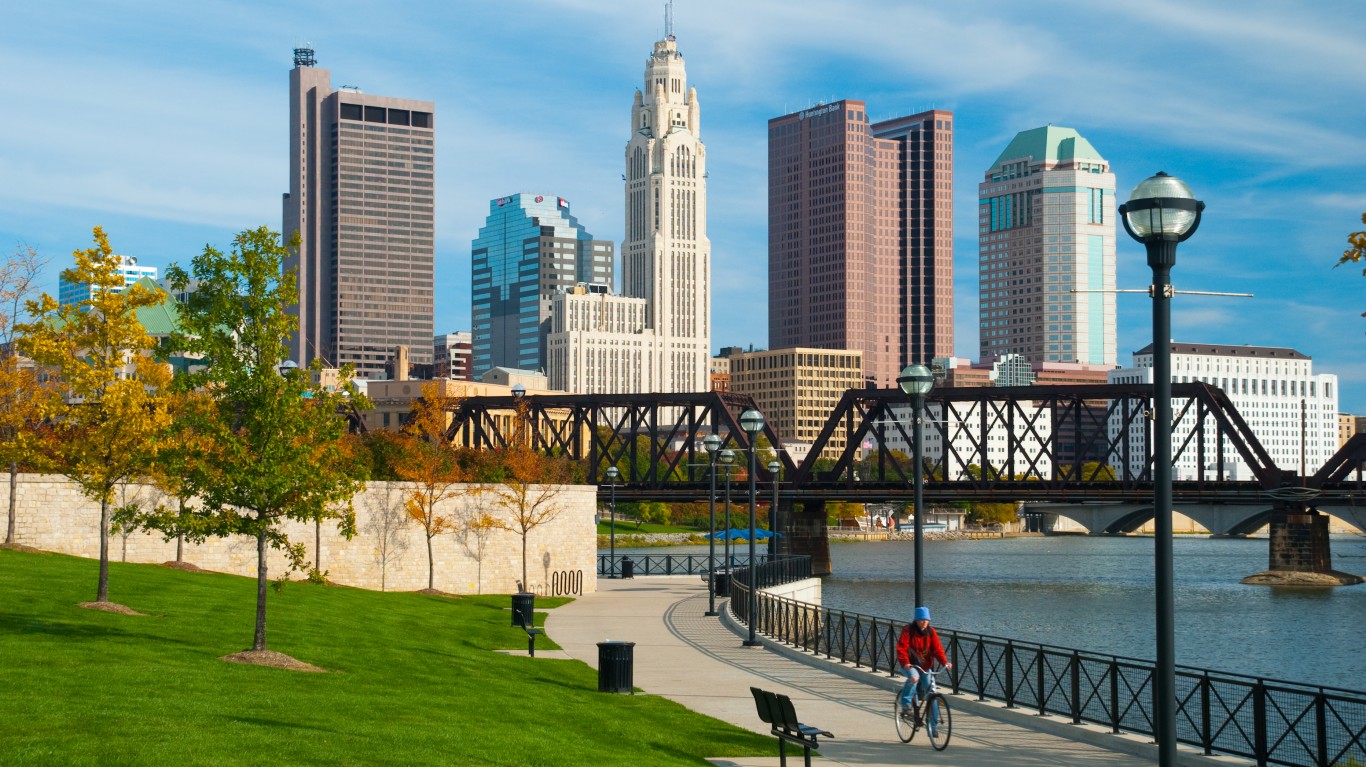
28. Columbus, Ohio
> Bicyclist fatality rate: 1.2 per 1 million people
> Bicyclist fatalities: 1
> Population: 852,144
> Total traffic fatalities: 53
> Working-age pop. commuting by bike: 0.7%
Columbus is already home to 110 miles of off-road bike trails, many along rivers and creeks, and when construction of the 320 mile Ohio to Erie trail is complete, the city will be connected by bike trail to Cleveland and Cincinnati, as well as the two other most extensive bike trail regions in Ohio.
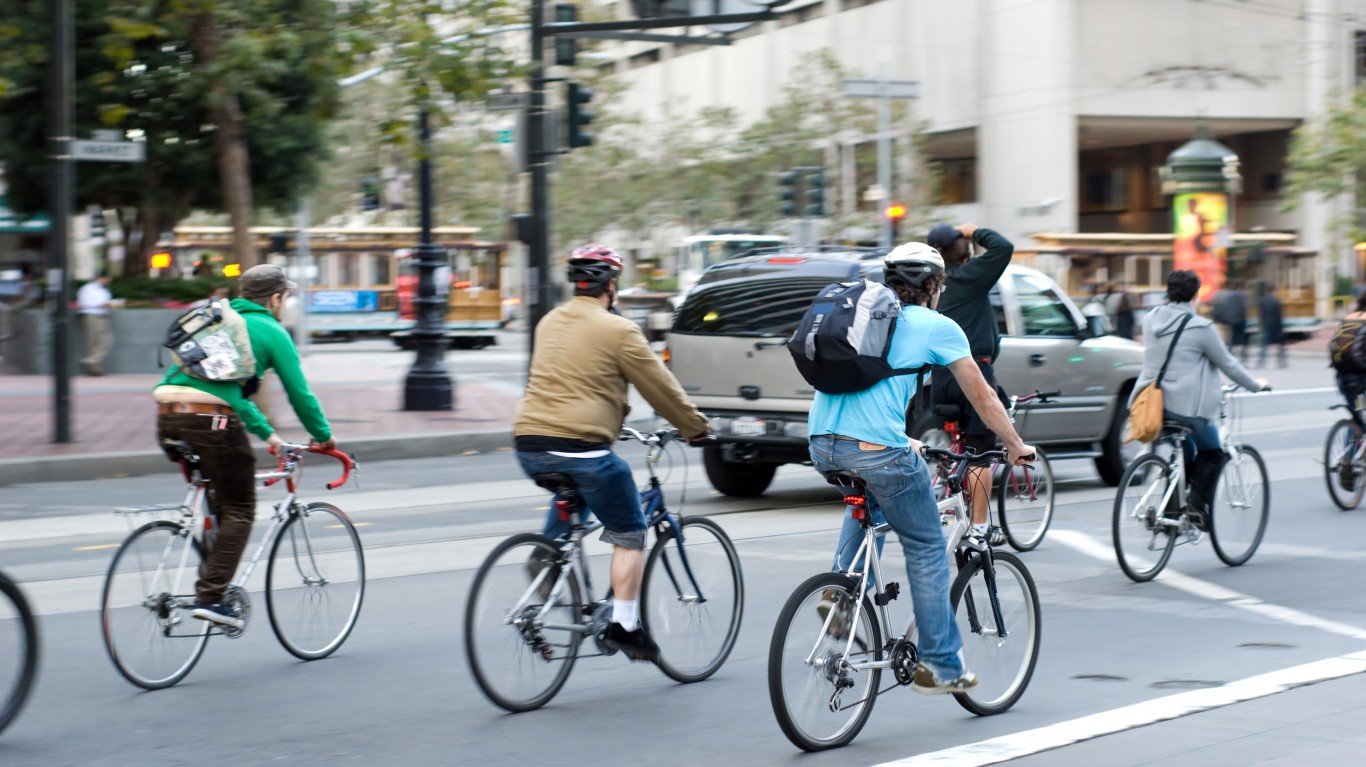
29. San Francisco, California
> Bicyclist fatality rate: 1.1 per 1 million people
> Bicyclist fatalities: 1
> Population: 864,263
> Total traffic fatalities: 28
> Working-age pop. commuting by bike: 3.9%
San Francisco, where a relatively high 34% of commuters take public transit, has a relatively low rate of traffic fatalities compared to cities of similar population. There were 28 traffic-related deaths in San Francisco in 2016, compared to 96 in Indianapolis and 149 in Jacksonville. With over 16,000 bike commuters and a relatively low fatality rate, San Francisco is a safe place to bike.
[in-text-ad-2]
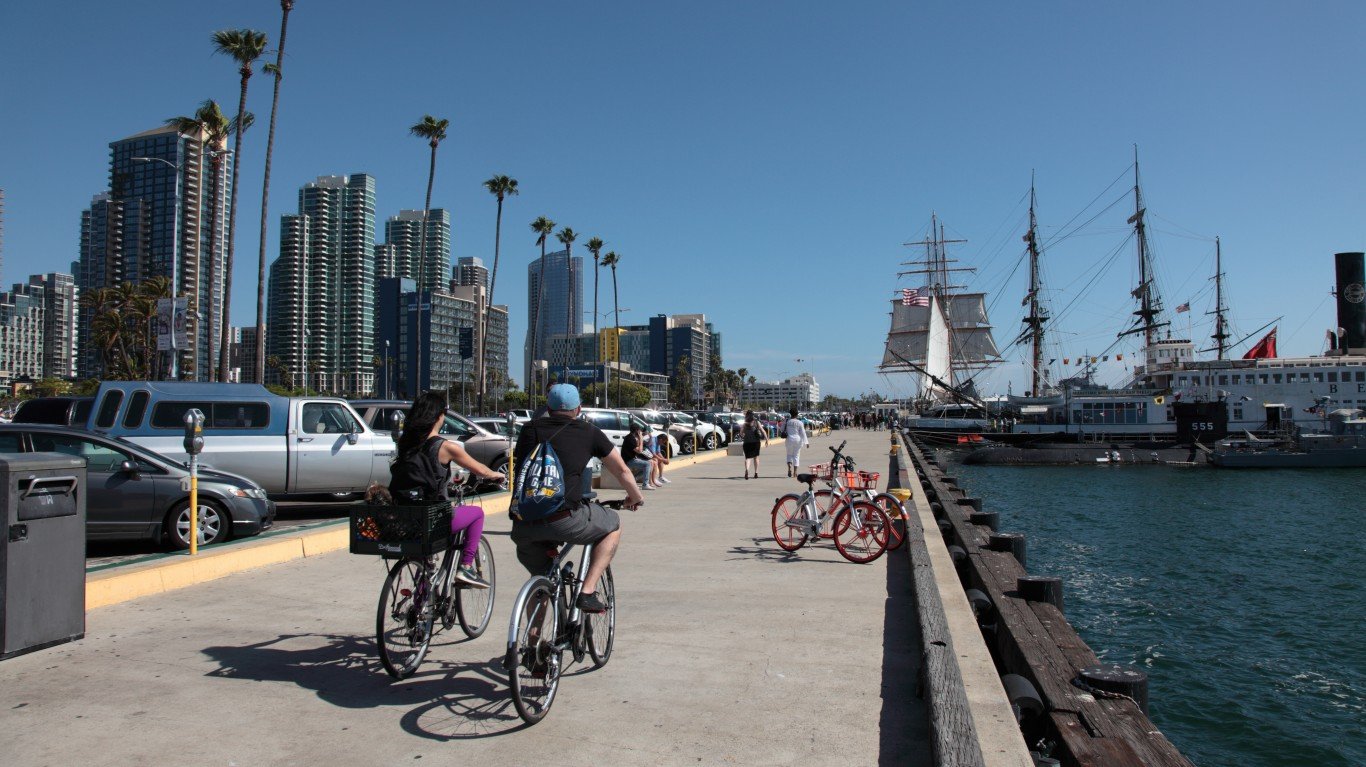
30. San Diego, California
> Bicyclist fatality rate: 0.7 per 1 million people
> Bicyclist fatalities: 1
> Population: 1,390,966
> Total traffic fatalities: 96
> Working-age pop. commuting by bike: 1.0%
Cyclists in San Diego have access to an interactive map of bike lanes that helps them plan a safe route to their destination. The city already contains many protected bike lanes and is planning on installing more lanes and expanding safe biking routes as part of its Bicycle Master Plan.
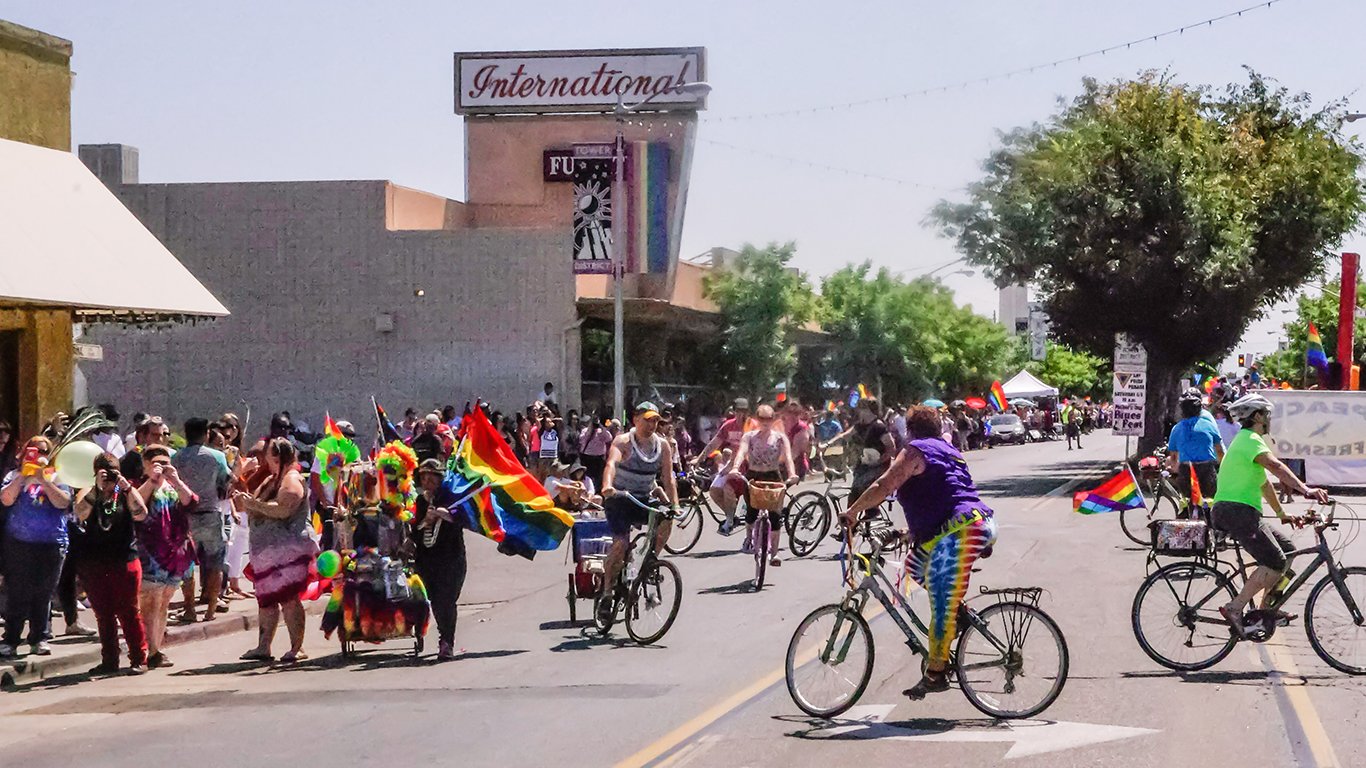
31. Fresno, California
> Bicyclist fatality rate: 0.0 per 1 million people
> Bicyclist fatalities: 0
> Population: 519,037
> Total traffic fatalities: 13
> Working-age pop. commuting by bike: 0.9%
Like many cities in California, Fresno has been implementing plans to increase pedestrian and cycle commuting to cut back on air pollution and bring more foot traffic to businesses. As a part of Fresno’s Active Transportation Plan, the city’s 491 miles of bikeways could triple.
[in-text-ad]

32. Boston, Massachusetts
> Bicyclist fatality rate: 0.0 per 1 million people
> Bicyclist fatalities: 0
> Population: 669,158
> Total traffic fatalities: 27
> Working-age pop. commuting by bike: 2.1%
Boston is another safe city for cyclists that happens to have a large public transit system, which 33.6% of commuters take advantage of. Boston has an extensive network of bike lanes, and the city is constantly upgrading its cycling infrastructure to make it safer, adding buffers, increasing the number of protected bike lanes, and adding cycle-specific traffic lights to intersections.
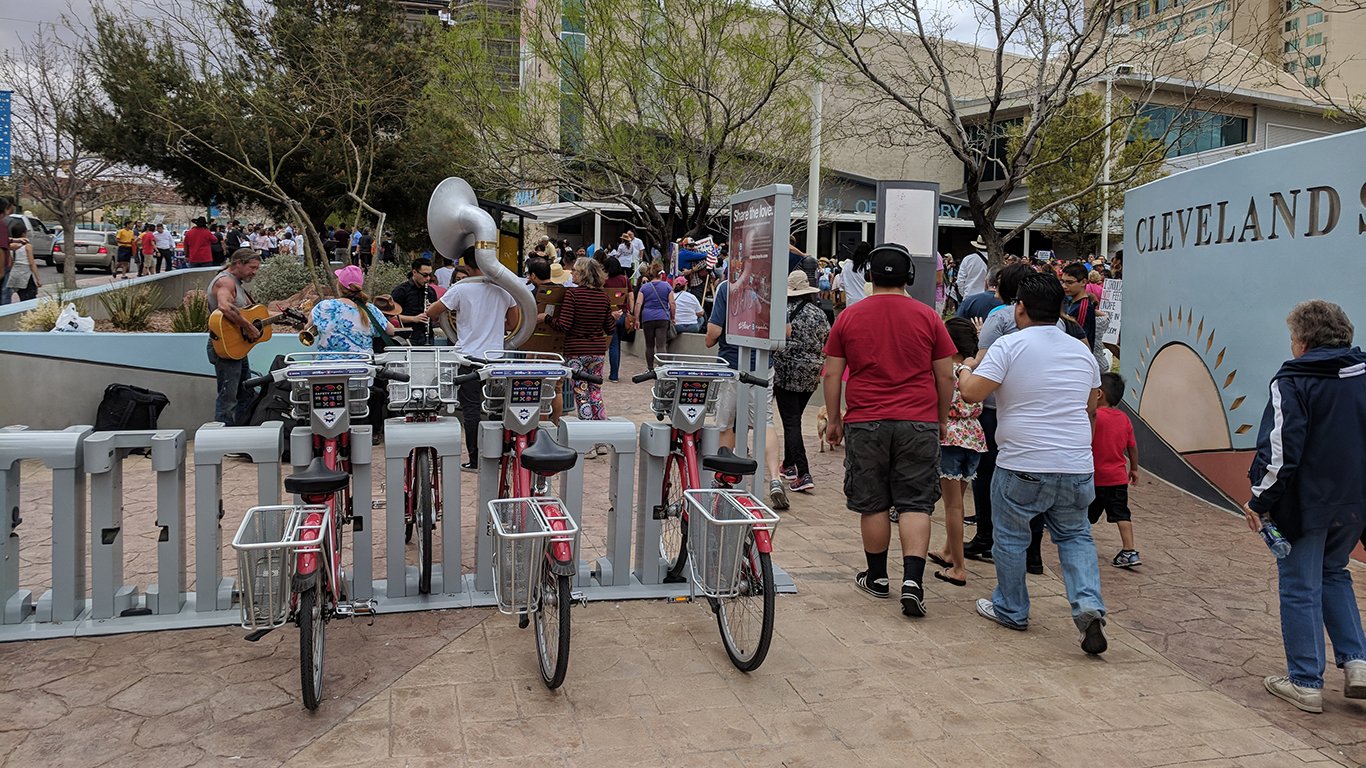
33. El Paso, Texas
> Bicyclist fatality rate: 0.0 per 1 million people
> Bicyclist fatalities: 0
> Population: 678,266
> Total traffic fatalities: 67
> Working-age pop. commuting by bike: 0.2%
El Paso adopted a Comprehensive Bike Plan in 2016 to improve the safety of the existing cycling infrastructure and add protected bike lanes and two-way cycle tracks. The city plans to create a completely connected network of bike lanes. The project will cost $3.5 million, and phase one is slated to begin construction this year.
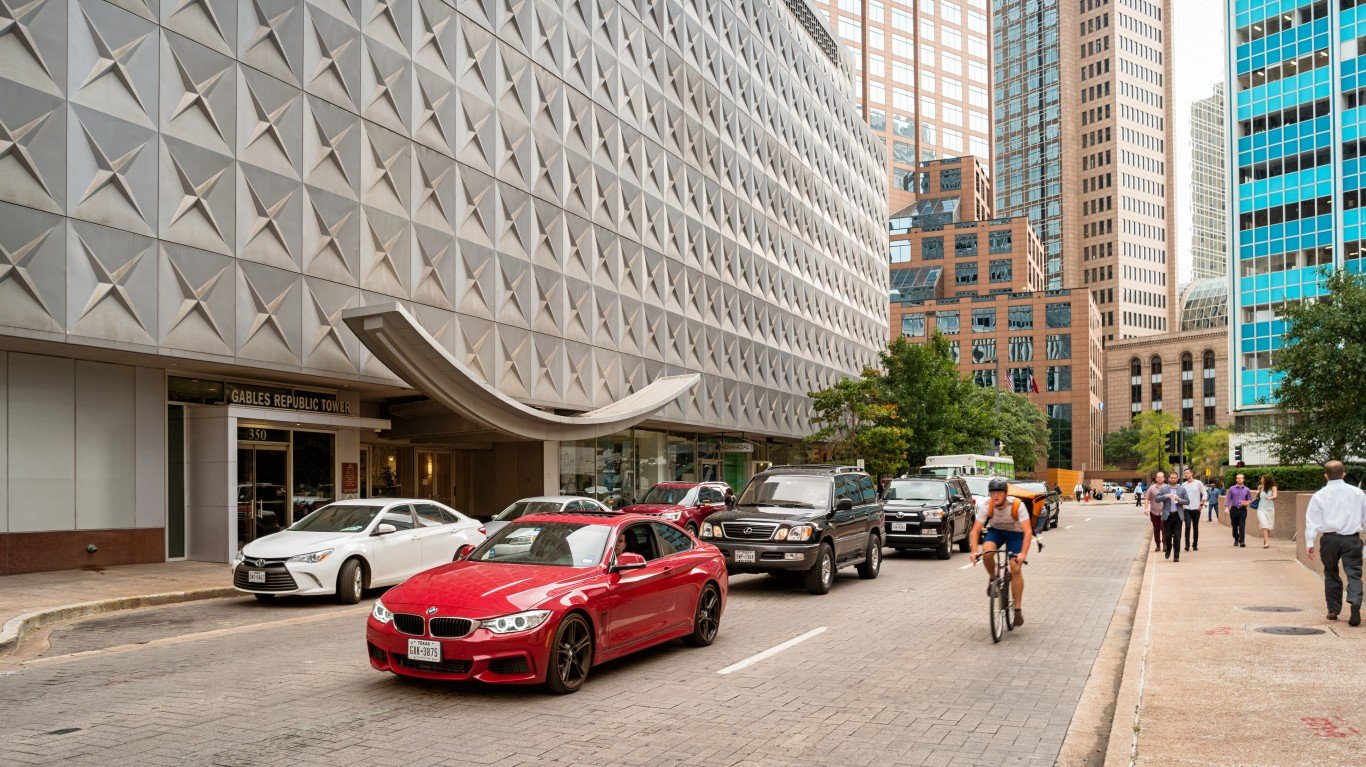
34. Dallas, Texas
> Bicyclist fatality rate: 0.0 per 1 million people
> Bicyclist fatalities: 0
> Population: 1,300,122
> Total traffic fatalities: 190
> Working-age pop. commuting by bike: 0.2%
As of 2016, Dallas had 140 miles of off-road bike trails and almost 50 miles of bike lanes. The city plans on adding over 50 miles of trails and 26 miles of new bike lanes to connect the existing cycling network, making one of the safest cities on our list even safer for cyclists.
Take This Retirement Quiz To Get Matched With An Advisor Now (Sponsored)
Are you ready for retirement? Planning for retirement can be overwhelming, that’s why it could be a good idea to speak to a fiduciary financial advisor about your goals today.
Start by taking this retirement quiz right here from SmartAsset that will match you with up to 3 financial advisors that serve your area and beyond in 5 minutes. Smart Asset is now matching over 50,000 people a month.
Click here now to get started.
Thank you for reading! Have some feedback for us?
Contact the 24/7 Wall St. editorial team.
 24/7 Wall St.
24/7 Wall St.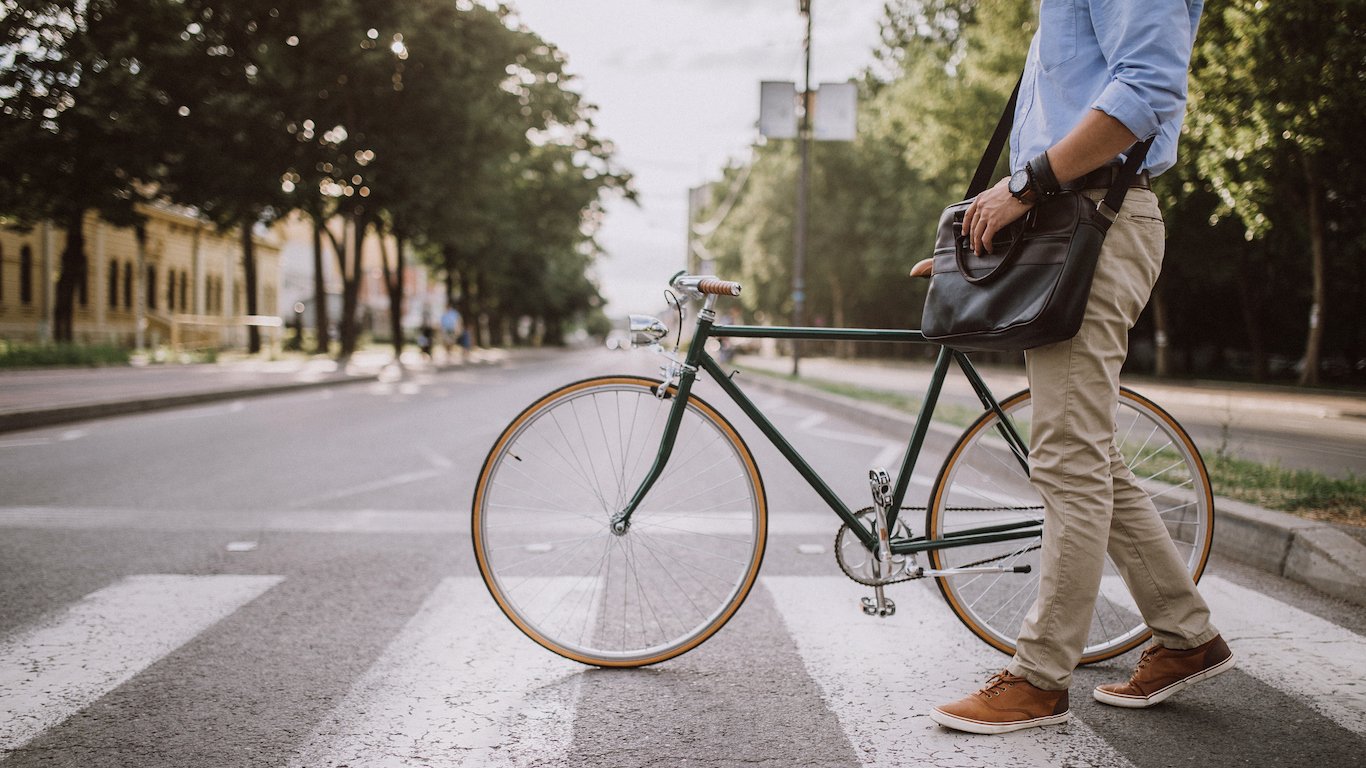 24/7 Wall St.
24/7 Wall St. 24/7 Wall St.
24/7 Wall St.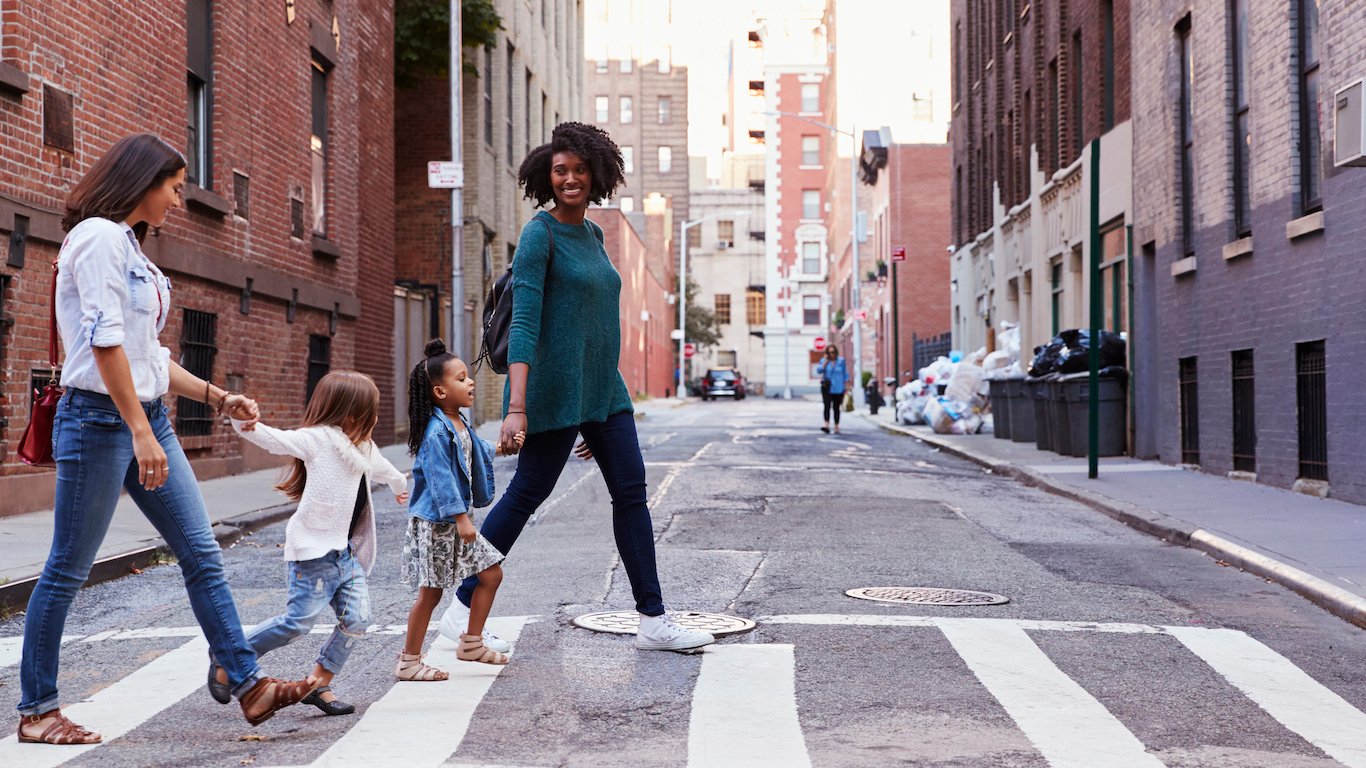 24/7 Wall St.
24/7 Wall St.
